#it does have a basic armature!!
Explore tagged Tumblr posts
Text
just made some BONES :3 (aka I'm finally starting a Harrow cosplay and obviously the rigcage is first. day 1 progress pics and process under the cut)
I have a PLAN for the ribcage, and we shall see if it can come to fruition. if all else fails, I will still have some sick wall art 👍
Pt. 1 is making the sternum, I'm embedding a wire armature for support and also to integrate secure rings-i-can-attach-other-bones-to directly into the bone, to hopefully minimize future cosplay emergencies and malfunctions. I AM making the sternum 3 different articulating bones, because they are important #TO ME

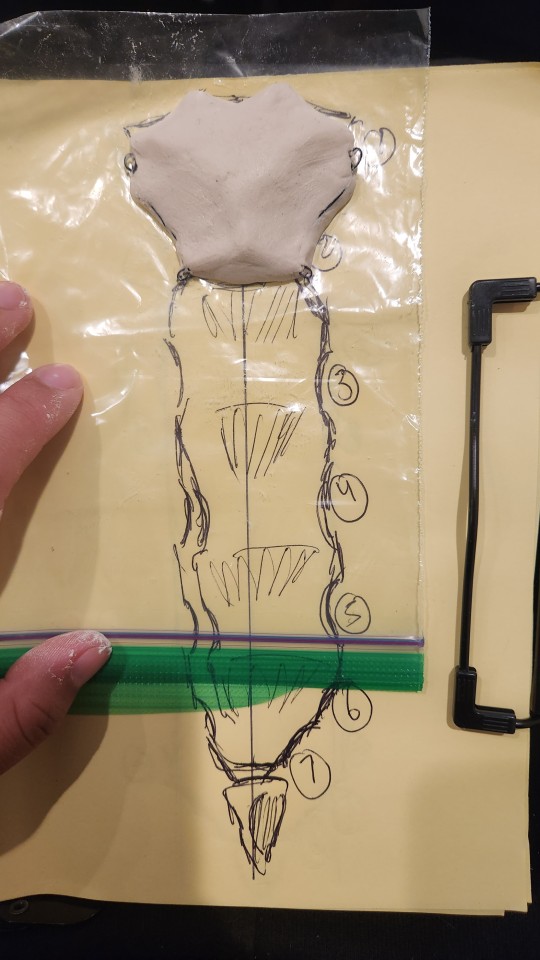
I'm using paper clay (which i have never used before) because I have a very contentious relationship with foam clay and I dislike baking things in my oven (its a very bad oven. and very small). Trying lots of new things so let's see what happens!
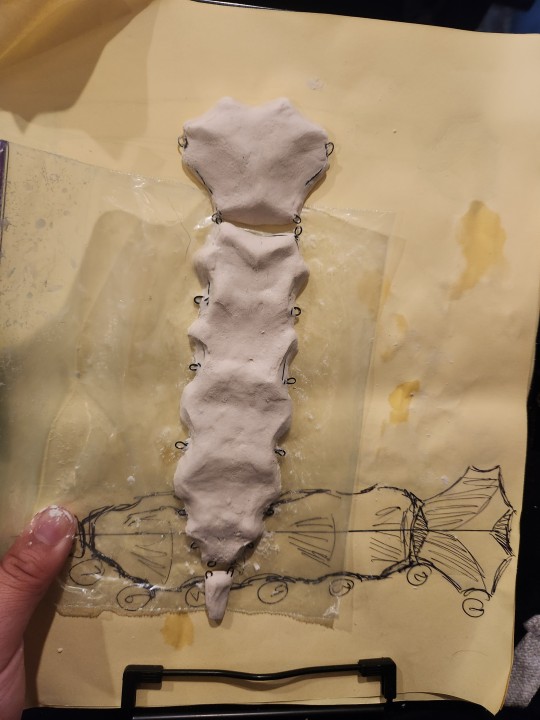
Pt 2 is the vertebrae. I want to make a spine that goes down the back over MY spine, so I'm making basically the entire thoracic section, posterior part only as it is like, on my body. Cutting it at the pedicles if you catch my drift. Using wire again for both structural and rings-to-attach-other-bones reasons.
Fun fact, a good way to remember if you are looking at thoracic vertebrae is "does it look like a giraffe?". (lumbar vertebrae look like moose. meese?)

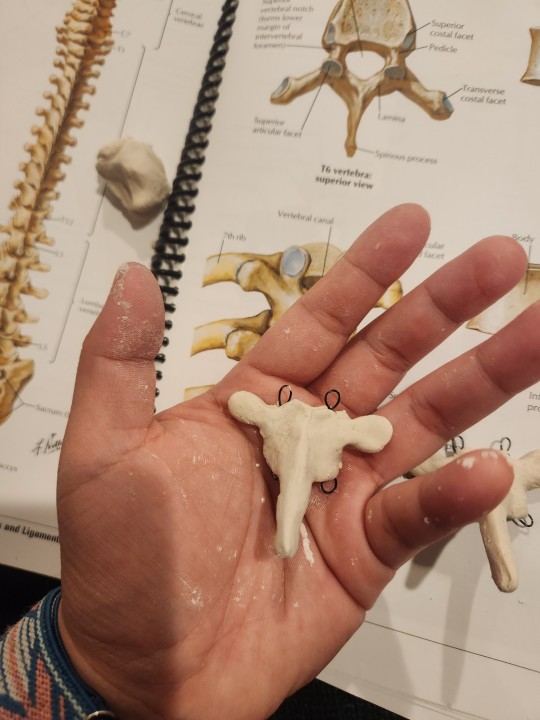
I'm basically making the connection between vertebrae happen at the junction of the articular facets, aka not sculpting those and keeping that part as wire only. I also has a really fun time making vertebrae that *progressed* from T1 to T12, aka from "looks kimda like cervical" to "looks kinda like lumbar". Definitely not perfect but good enough IMO. Yippee!
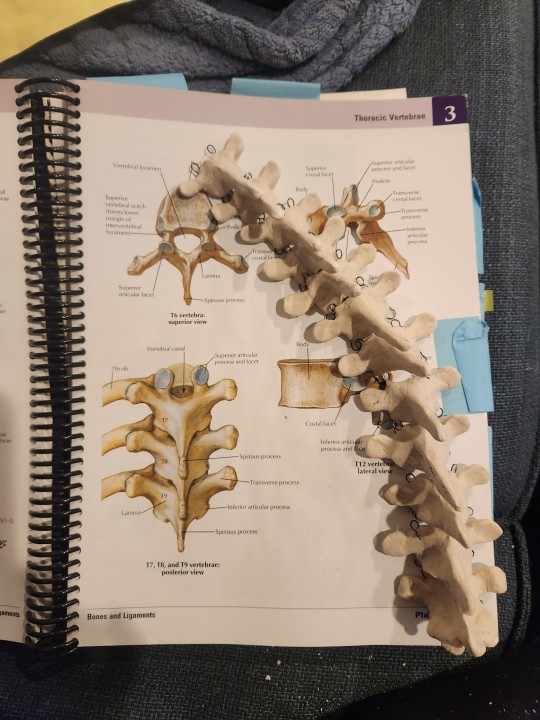
definitely should have like, considered rib attachment and such when I was making the armature for the vertebrae BUT i forgot. so we ball. I think I will attach them to the main articulating chain and just like... attempt to space it out with jump rings. we shall see if it works.
Next steps are scapulae, clavicles, and ribs. Still sorta unsure how ribs 1-4 ish are going to work due to my arms being in the way but I will figure that out when I get there 👍
#harrow cosplay progress tag#cosplay progress tag#trb.txt#YAYYYYYYY#it is. after midnight. were mistakes made or does this count as studying?#why dont you do arts and crafts for 5 hours and then you will calm down#will be doing butch harrow obviously. bone gremlin supreme
239 notes
·
View notes
Note
What’s some behaviours that seeker Lennox do that unnerve the humans or other bots that don’t fly?
The new Seekers/ex-humans sleep a lot compared to the Autobots to the point that mechs were concerned over the newbuilds. It's just the remnants of the human circadian rhythm, Cybertronians function on a far longer time clock, so they'll eventually adjust to it.
The humans think that the lovebirds are too into each other since Will and Sarah are basically wrapped up with each other in spare time. Freaks out some humans when they meld their frames partially together. Meanwhile, the Cybertronians are going, "Yep. That makes sense. Those are newly wedded and bedded newbuild Seekers." It's really intense, somewhat uncomfortable on how aggressive affectionate they are, but still understandable. Some mechs are making secret bets on when and where a poor squishy will see the natural sight of two Seekers going down and dirty.
It took a while for the human personnel to understand why the Seeker pair shower together or have someone else with them. It's a natural extension of their new frame sociality matrix since grooming a wingspan needs an extra pair of hands and it's a pleasant bonding activity. Ironhide is their usual go-to, but they had taken Optimus and Ratchet into their shower sessions.
Some of the Autobots think that Sarah is highly territorial and standoffish since she constantly wraps Will up with her own field and likes a certain degree of space. The Arcee sisters are careful not to stand too close to Will for that reason as they don't want to be seen as issuing a potential Challenge. Will doesn't understand it, but his frame does and likes it since it's a low-key awareness of where his wife and child are. Ironhide is trying to wrangle it back into more neutral feel, but Sarah isn't having it.
Sarah enjoys rising with the sun as she did her early morning yoga routine. It freaked out the Cybertronians how flexible her frame was, especially with her armor density.
None of the Cybertronians are ready to see how blase the Lennoxes are with doing things unarmored, especially when the Autobots caught up with the pair when Sarah managed to locate another vein and she was taking a dip in a geyser. Just her bared legs. Or whenever they shower together since humans take off their clothes, but Cybertronians are able to shower with their armature on.
Oh, and here's a little snippet:
“So besides the wings and chicken legs, what else you got?” Epps asked.
“I can literally smell everything half a mile away,” Lennox took in another deep vent, his mouth parted open similar to an insect’s mandibles, playing it up as his frame shifted to accommodate the air and his tongue flicked out. Epps looked up in wide-eyed, horrified fascination, at the long, segmented appendage coiling in the air.
“Man, you’re just fucking with me at this point.”
“Well, it was chili night.”
“Foyer’s?”
“Yep.” Both mech and human stared at the distant mess hall.
“I can already smell the barracks tonight. Thor will be blowing thunder all night long."
#ask#transformers#transformers bayverse#bayverse#lennox seeker fam au#james epps#william lennox#sarah lennox#ironhide#humans into cybertronians#humanformers#culture clash#cultural misunderstandings#cultural differences#cybertronian culture#cybertronian biology#maccadam#my thoughts#my writing#they have a guy who's callsign is Thor since he looks like a Viking and has earthshattering farts
76 notes
·
View notes
Text
After referencing numerous diagrams, avian necropsy records, and my own prior knowledge of human musculoskeletal structure, I have devised speculative anatomical structure for Chozo.
We'll start small with my first attempts to properly chart basic skeletal structure from last year (seeing as how that's what I used as a jumping off point), then move on to the research-based stuff. I wanted to walk through the process of solving problems presented by the skeletal structure.
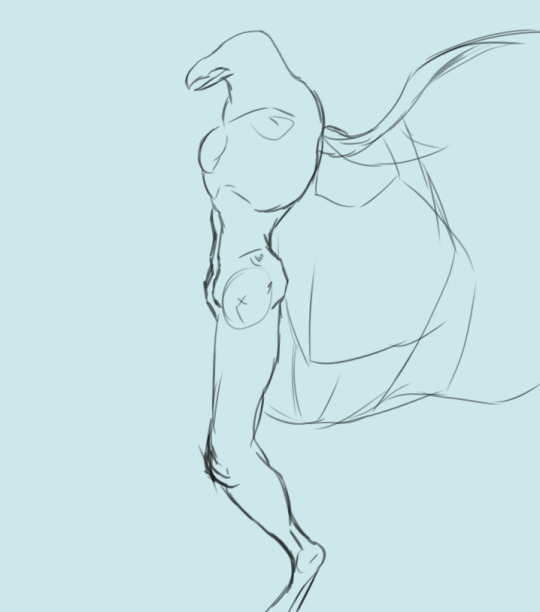

First we have a cursory look at the ribcage. Drafted June 7, 2023. Leaning into the more humanoid appearance.
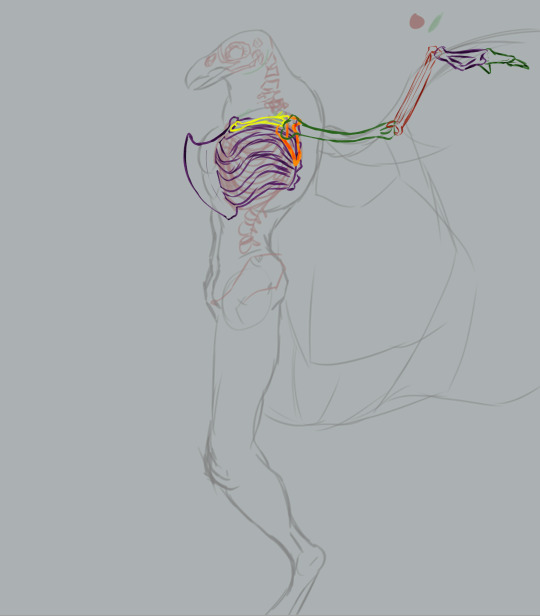
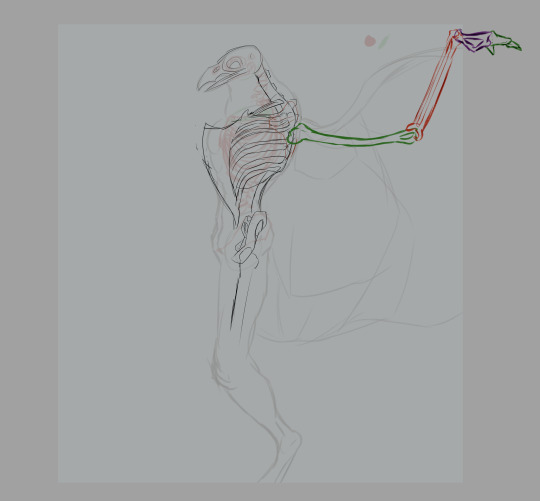
New addition, May 2024: a first shot at sussing out wing bones. These bones need to be much, much larger to accommodate the full breadth of the limb: this is just a rough outline. The skeleton also needs to bear muscles that are strong enough to carry the Chozo in flight, hence the new protrusion on the chest: a keel. Two variants of this new breast came out of this drawing session: one with a large keel that extends below the sternum and one with a normal keel.
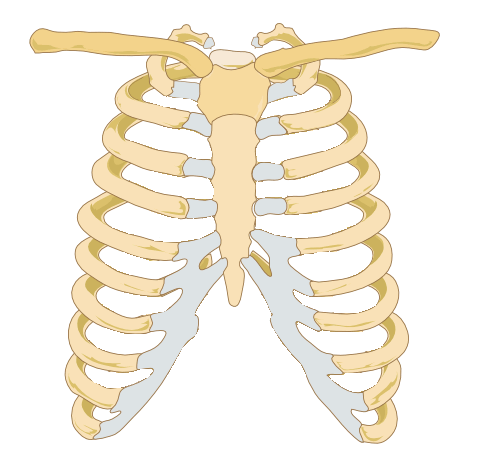
Image credit: Wikipedia
Human ribcages have this ridge along the bottom that the last six ribs are attached to (noted in grey on the image above). We're not doing that with the Chozo ribcage.
The sternum is the structure in the middle, which the ribs are attached to. See those two bones attached to the top of each side of the sternum, stretching away from the center of the ribs and forming sort of a capital "T" silhouette? Those are the clavicles. When you're drawing any humanoid form, the clavicles are an excellent landmark (and as I've been taught, the first place you should start on anatomy after you've laid out your pose, armature, etc).
It's also part of why wings are so difficult to suss out on Chozo skeletons. In birds, a bone that consists of a fusion of the two clavicles is a crucial part of flight: the clavicle bridges the gap between the ribs and the arms, and for birds, the wings are their arms. That's problem number one: effectively consolidating two pairs of arms on one torso.
We have a few bones to add onto the human skeleton in order to make flight possible for Chozo. First, we'll assume all bones are hollow. This makes them lighter, demanding considerably less energy to lift them off the ground in the first place.
I've modified the sternum to add a keel, which the base flight muscles are going to be anchored to.
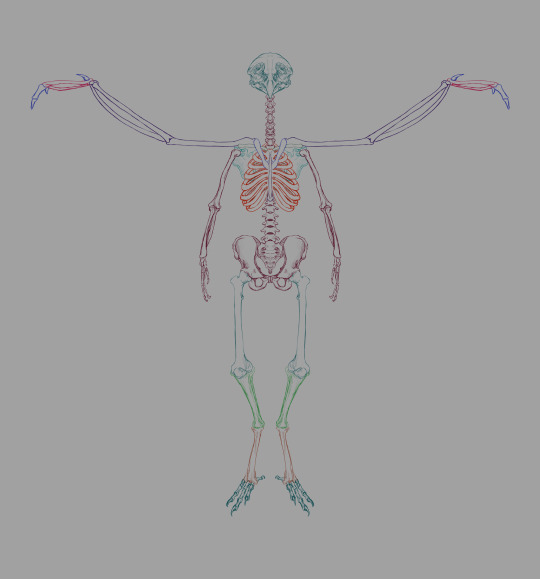
First pass at revising the skeletal structure. I made a few modifications unrelated to the wings. The pelvis is similar to that of a human, though a little wider to accommodate egg-laying. I may end up reworking the pelvis entirely to make it more bird-like, but I'm more interested in making those wings fit at the moment. Chozo have a human femur/patella, and avian lower legs.
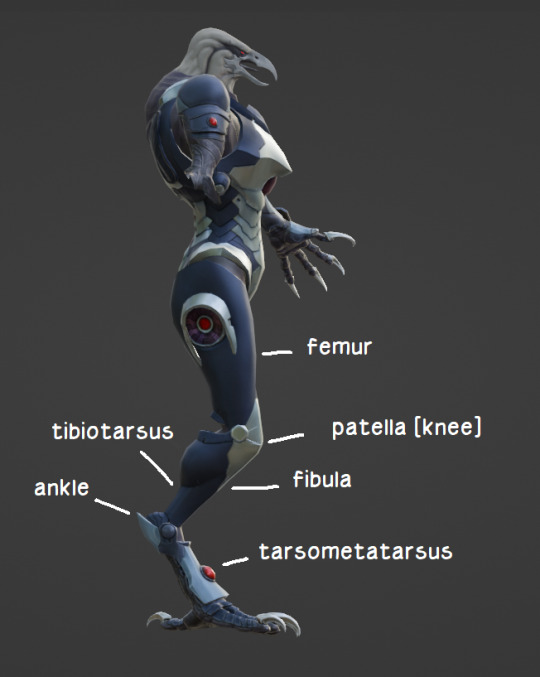
Here's a thing I slapped together in 3 minutes in January of last year to illustrate which bones are where for the layman. Onto different matters.
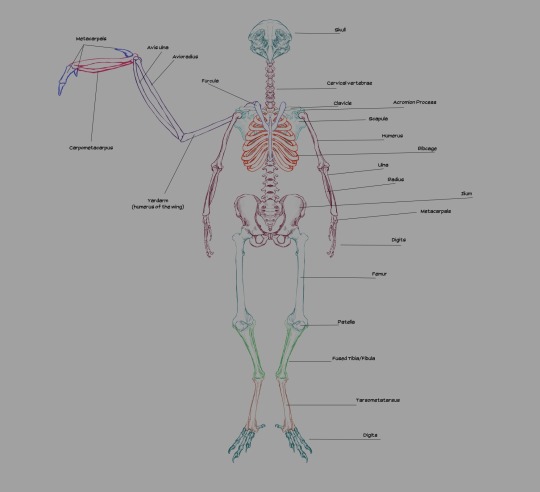
Skeleton, labeled.
Generally, the wings' humerus is attached to the scapulacoracoid, a bone attached to the keel that's sort of Y-shaped. That's how a real bird's shoulders are structured. Humans posses a scapula (shoulderblade), which has two protrusions: the acromion process and the coracoid process. The acromion process is where our humerus joins the shoulder. The coracoid process in humans is not exactly big enough nor ideally shaped to anchor flight muscles to.
At first, I had three ideas:
Invent a new bone attached to the keel that serves the function of the coracoid.
Modify the scapula to fit a new bone that anchors the flight muscles (the scapulacoracoid is analogous to the human scapula, after all).
Forego the keel and invent a bone on the spine that does the same thing.
To start, I added the furcula, a Y-shaped bone on the sternum, flanking the keel. Fun fact: not all birds have a furcula (better known as the "wishbone" in some parts of the world).
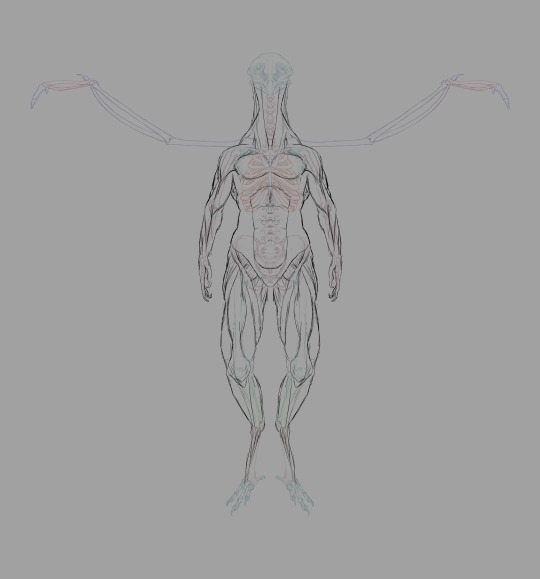
Real quick muscular structure layout sans flight muscles.

First pass at the flight muscles. Not the most accurate wing muscles in the world (neglected to depict the muscles near the tip of the wing, for one).
In this model of the musculature, a good deal of the flight muscles around the breast and torso are hidden by the pectoralis major, much like several non-flying human muscles.
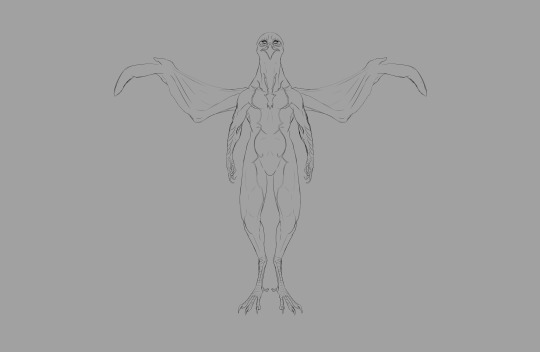
Flesh applied over muscle.
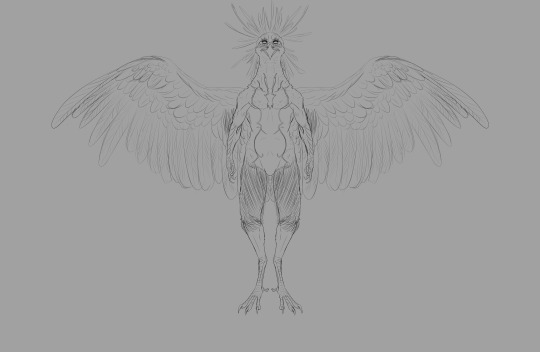
Feathers applied over flesh.
That was my first attempt at constructing the Chozo skeleton. You'll notice the wing bone solution is inelegant. See, wings are analogous to arms. Their metacarpals are finger bones. In order to give Chozo both arms and wings, we'll need to deviate from both avian and human skeletal structures to make the pieces fit together.
I can't make the flight muscles stretch comfortably over the clavicle: that has the potential to impede motion in the arms. My first idea in the second round of flight bone shenanigans was to invent a second bone that fit between the spine and the scapula, like shoulder-bound plate tectonics (working name "scapula trellis"). I wasn't wholly confident that I could configure flight muscles in a logical manner even with this setup.
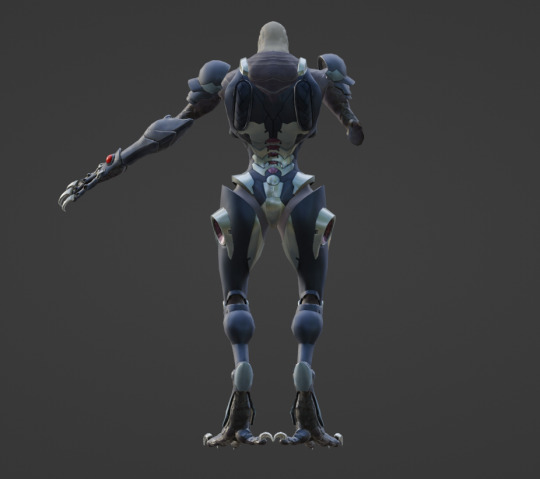
At one point I consulted Raven Beak's model. Note the patches on the back of the torso on the powersuit: that's where the wings emerge in phase 2. It looks like they're anchored to the scapula or an adjacent structure.

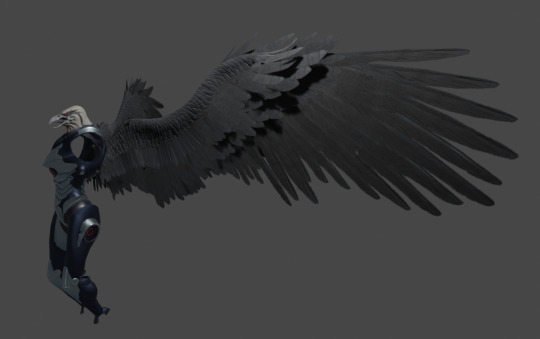
Barring the fact that his wings are absolutely ridiculous, I wasn't sure I could work with this. Gorgeous structures, but the feathers don't seem big enough to handle flight.
So I was left to brainstorm, and drafted up a few sketches for a second scapula to anchor the wings' shoulder joints to. I was more confident in this than I was the previous design, but I wanted to fish for ideas from other parts of nature.
Enter dinosaurs. Specifically, the Pteranodon with its shoulder girdle.

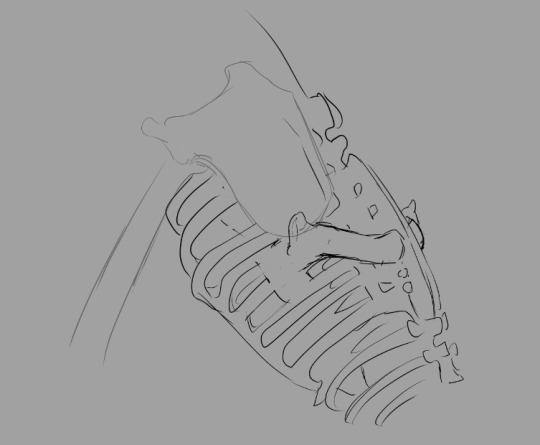
The addition of a shoulder girdle as an anchor for the yardarm (the term I'm using for the humerus of the wing, applicable only to creatures that have both wings and arms) seemed like a better solution. Positioning it below the scapula allows me to place the wings a little lower on the back, providing minimal interference between the two sets of limbs.
Whether we're rolling with the shoulder girdle or a second scapula, the intended result is the same: the wings have moved down on the back of the torso (personally, I'm digging the girdle, but the second scapula is on the table if anyone else wants to try their hand at this).
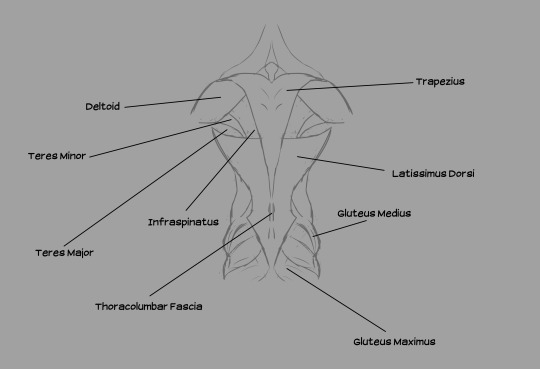
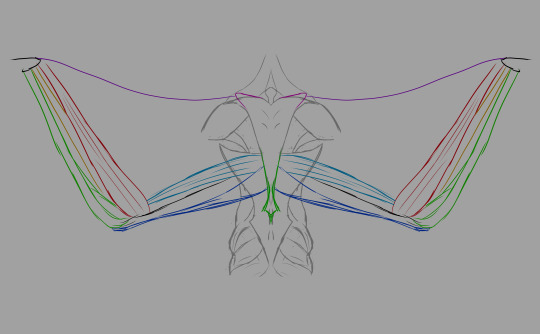
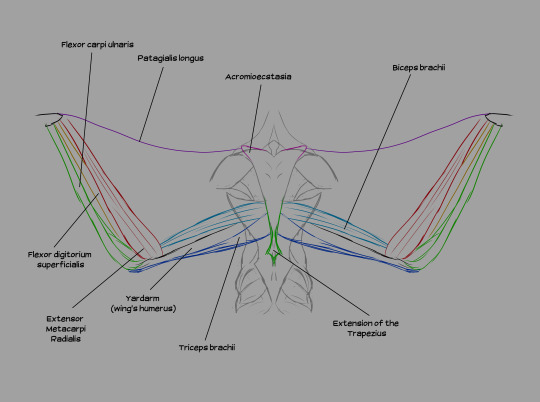
Muscles from the back, illustrated. Note the distance between the deltoid (shoulder muscle) and the wings. The shoulder girdle is situated in the lower-middle of the back of the ribcage.
A few notes: the acromioecstasia exists because the muscle that usually connects between the body and the patagialis longus on real birds is located on the pectoralis major. If I emulated that, we'd have flesh crossing over the deltoid to reach the front of the body, which would obstruct movement of the arms. We don't want that, so I moved that section of the wing to the back. We're compensating by adding additional musculature up front.
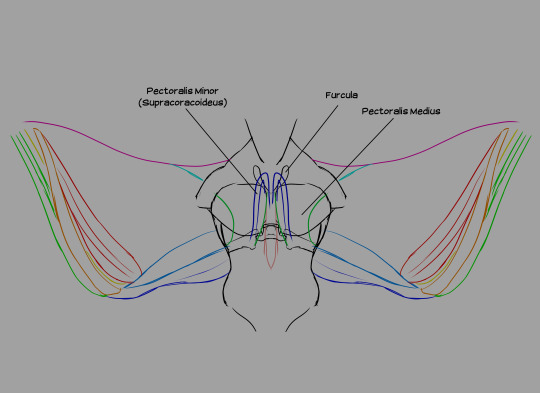
Wing muscles from the front. All three pectoral muscles are attached to the keel. The pectoralis medius is an extension of the pectoralis major, running beneath it and several other muscles. The pectoralis minor (also known as the supracoracoideus) lies beneath both the major and the medius. The pectoralis medius and major are responsible for the downstroke, while the supracoracoideus raises the wing between flaps.
Flight is very taxing on the individual. Power suit wearers actually have an easier time flying than non-wearers because the suit passively offsets the metabolic demands of flight with its own Energy.
It's important to note that these sizes are not necessarily "to scale". Chozo wings should actually be much bigger than my canvas permitted me to show. I had to keep increasing the size of the canvas on one of my files to accommodate a reasonable wingspan, but even that's not broad enough! I had to stop expanding the canvas for the sake of my CPU. If any muscles look too dinky or the scale seems off on some bones, that's why: I just needed to swiftly illustrate where things are.
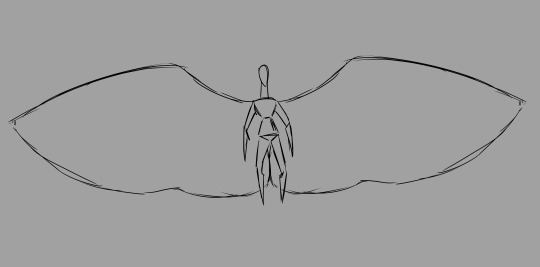
A Chozo's total wingspan should at least be twice the individual's standing height. Any smaller and there's no lift.
I still don't necessarily consider the wings "solved": if any speculative biology enthusiasts want to weigh in further on the subject, feel free!
After laying out the bulk of the skeleton (and before solving the wing problem), I decided to go a little further in my studies. Thus, we have organs.
First, the digestive system.
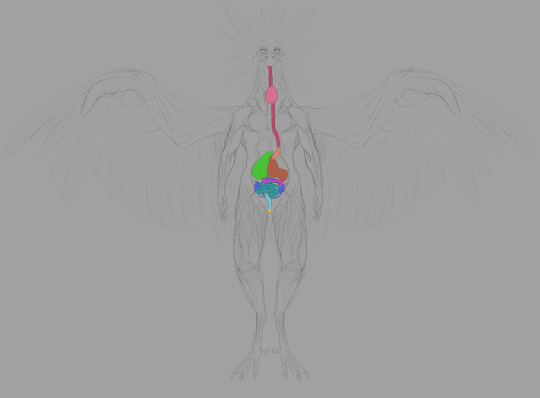
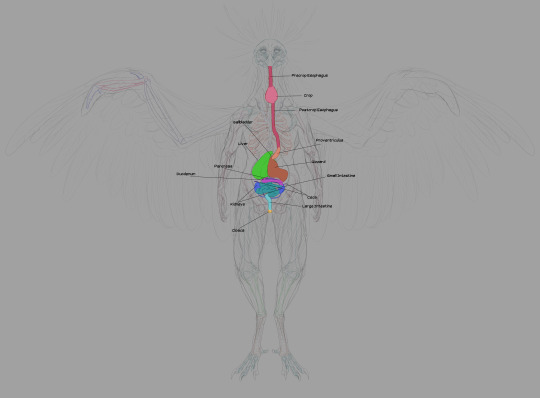
The esophagus is self-explanatory. Food goes in through the beak, traveling into the body through the esophagus.
The crop is used to store food: this is where digestion begins. Many parents regurgitate mushy, enzymatic food for their children from the crop. Very nutritious and promotes growth.
The proventriculus is the first half of the stomach: protein bonds begin to break down here. Gastric fluid produced here aids the gizzard in mushing things.
The gizzard is where the bulk of food-crushing occurs. Breaks larger matter down through transfer between areas within the organ.
The liver and gallbladder are crucial in digesting fats. Real bird livers have two lobes: the left is smaller than the right. Two bile ducts from the liver connect to the distal duodenum: the right duct is connected to the gallbladder. Chozo only need one.
The duodenum is the start of the small intestine, running in tandem with the pancreas. Pancreatic enzymes created by the latter assist in completing digestion, processing sugars, etc.
Digestion is finished in the other sections of the small intestine, where nutrients are absorbed.
Chozo kidneys largely resemble their human counterparts. Connected to the lower half of the gastrointestinal system. Urate is disposed of through the cloaca, transferred from point A to point B by the thin ureters bridging the kidneys to the large intestine.
Bacterial fermentation in the ceca extracts nutrients from plant material that can't be digested through enzymatic breakdown. The ceca and large intestine also reabsorb moisture, forming the solid portion of indigestible waste. The ceca are larger in tribes that eat more fruit and other plant products. Mawkin ceca are fairly small: they live quite an active lifestyle, and plant matter supplements their all-rounder diet with meat as the foremost staple.
The large intestine is the end of the line. Renal and intestinal waste is ejected here. The end of the reproductive tract forks to the distal segment to facilitate egg laying. Mammals have considerably larger large intestines than Chozo to dry out waste before expulsion.


Next we have the respiratory system. The trachea takes in air and delivers it to the lungs. Unlike mammalian lungs, Chozo lungs are inelastic: they don't expand and contract. The air sacs do all the expanding and contracting: they're connected to the lungs through a network of bronchii.
The high metabolic rate required for flight demands a ton of oxygen, and Chozo respiratory organs are designed to do just that. The mechanics are fascinating but I won't take up too much of your time explaining the finer points. Wikipedia's write-up on the circulatory system of birds is a good place to start if you want to dive deeper.
The short version is thus: air enters through the nostrils, traveling into the bronchi through the trachea and syrinx (the syrinx helps Chozo vocalize). The bronchi deliver air to the lungs. When Chozo inhale, the posterior and anterior sacs expand: the posterior sacs take in fresh air while the anterior sacs fill with air that has already passed through the lungs. Air is constantly circulating through the lungs, and it's a one-way flow.
Parabronchii are microscopic tubes that run perpendicular to the blood capillaries. Parabronchii efficiently diffuse oxygen from the air into the blood.
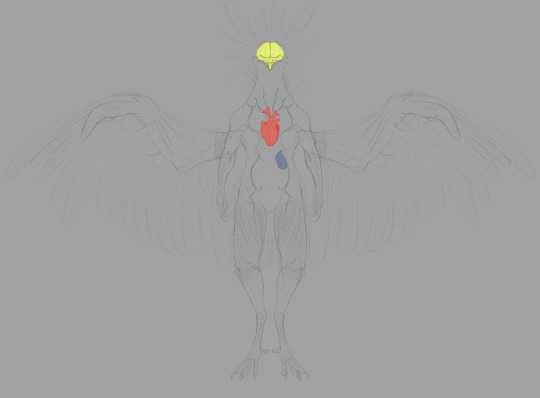
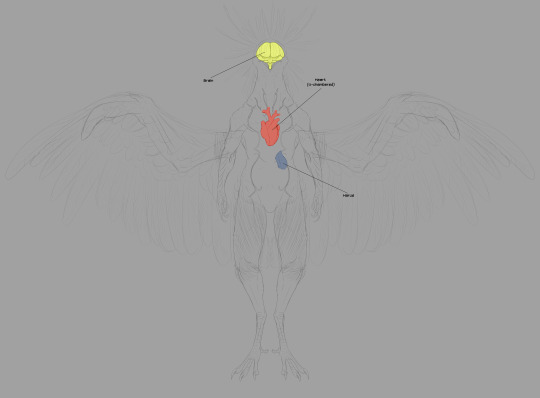
The next image set deals with a few extraneous vital organs. I'm not going to illustrate the nervous system nor arterial network, just as I neglected to illustrate all the bronchi in the respiratory system. That's a lot of tubes!
The circulatory system is pretty standard, but it pulls largely from Dread. Here's the thing: in the pre-boss fight cutscene for Raven Beak (aptly named 0086_comanderorbital_video_artwork_01.webm in the files), we see him contributing to Samus' biological makeup. His heart is set firmly in the center of his chest.
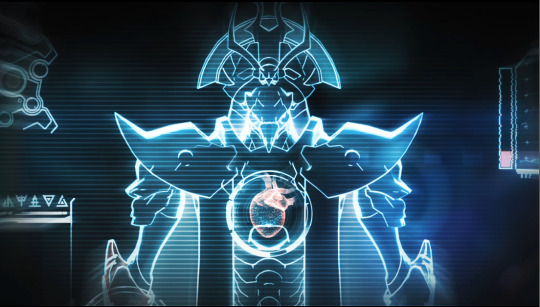
This is anatomically accurate to real birds! Bird hearts are placed similarly in the center of the chest, flanked by the left and right lobes of the liver (linked image is a labeled black and white illustration of a dissected pigeon, showing most of the major organs).
The brain is exactly what you think it is. No, the most interesting part of this last image set is the harus.
The harus is an accessory to the lymphatic system. You'll notice its proximity to the respiratory system. Lymphatic capillaries accompanying the parabronchi network filter more harmful atmospheric molecules into the harus, which makes use of specialized cells to recycle these molecules in a process that synthesizes ATP. In addition to this, the harus helps maintain the body's proper pH levels in hostile environments. This organ is what allows the Thoha to breathe in Zebes' toxic atmosphere.
Headcanon time: the majority of non-powersuit related genetic alteration done to Samus Aran in her youth is related to this organ: her respiratory system was altered with the proper instructions to produce specialized harus cells on their own without needing to transplant the organ. Samus can breathe on Zebes because her lungs can perform the function of the harus while she breathes.
Full-size pngs for everything are available on Ko-fi and Patreon. The canvas for this project was pretty big because I wanted to be able to capture the scale of the wings somewhat.
ADDENDUM, May 16, 2024: Chozo should have a modified pelvic bone that more closely resembles a synsacrum, not a humanoid ilium: I am a fool and completely forgot to make alterations in that department.
#headcanons#chozo anatomy#chozo#raven beak#metroid#metroid dread#metroid dread spoilers#gotta give props to friend of the blog Ivory who reminded me of ATP synthesis and suggested a second liver of sorts
101 notes
·
View notes
Text
So far, out of all the new traditional clays I've tried sculpting with over the past couple of months, La Doll Premix is the closest feel to digital sculpting. It blends easily and smoothly but it's dense enough to keep its shape and hold really high detail. Gotta be my favorite air-dry clay so far to sculpt with. Otherwise, I've tried:
Sculpey Traditional. It'll get the job done. It dries out over time but vaseline and cornstarch will recondition it to be workable again. It always burns for me so I usually have to cook it for less time than suggested. It bakes really really cakey so sanding and then smoothing with acetone afterward is a must but will give you a really smooth look in the end that holds paint well. It's on the cheaper side. It's toxic though.
CosClay Doll. My favorite bakeable polymer to use so far. Not too expensive. Bakes flexible, especially the thinner the pieces are because the blend is mixed with rubber. Non-Toxic. Affordable. Smooths really well with alcohol pre-bake. Doesn't smooth as well with Acetone post-bake as Sculpey. Bakes smoother and holds paint fine but still a bit bumpy and 'clay' looking which is always a peeve for me with bakeable clays. Still my favorite to use though. Really really holds its shape well.
BOHS Foam Clay. Ultra light-weight clay. It's... different. Air-dry clay but gravity is its enemy and heavy parts will droop badly without armatures and mesh frames. Has a really nice satin-suede finish but dries really fast. Best for simple basic-shaped things that don't take too long to make. Sticks to itself well and other surfaces well. Really good for clothes and thinner things. Some of the colors will bleed when mixed with water though which is problematic. Too much water turns it to a liquid. Once it starts to dry it's really hard to smooth or mold again. Not easy to blend or build onto itself. If you want to make little Mario Baddies or Pikachu, then this can be great, otherwise, more detailed things have always come out poorly for me. Since it's ultra-light clay it's incredibly moldable, which works against you if you're trying to hold onto and shape it at the same time. Dries really squishy and you can chuck your figures across the room and they'll bounce around instead of break which I just think is neat. Def hurled my Goomba around the room a couple times just to watch him bounce around.
Sculpey Souffle. Bakeable clay. Branded as baking smooth with a similar smooth satin-suede finish. Also in the 'too soft to really make anything that isn't flat or really complex with without a stamp' category for me though. I really did love how smooth it baked and how well it held paint. It's branded as not mixing color-wise either so you can make some really nice and cool jewelry with it. Not figures though, unfortunately, or at least, not in my case.
Then yeah, La Doll Premix. Loved working with it. Result wise smoothing and building with it was the closest in ease as digital sculpting and I was really impressed. Feel wise it was the same as working with CosClay, a decent soft enough clay to not tire out your hands or require a fancy pasta thing to condition but dense enough to keep it's shape and holds its shape really really well. I can't review anymore than that in this post though since I'm still waiting for my piece to dry. Out of all the clays this one held the most detail so far though and like BOHS, being air-dry, should allow you to 'edit' or carve into it or add water and add clay or resculpt/cut away pieces you want to change or don't like after it does dry. Which is a must for me. Hoping it is easier to sand and smooth than the bakeable ones and has a smoother finish and holds paint well. If it does, I can def see it being the main clay I use for figures going forward.
Porcelain Clay: Is still on my list to try.
Daiso 'Soft Clay'. Worst clay in the world. Dries in like a minute and becomes crumbly and unusable. Unconditionable. You can use it to make slime with or with a stamp/mold real quick but that's about it. Don't waste your money.
#clay review#sculpting#traditional sculpting#cosclay#polymer clay#air-dry clay#anime figure making#clay figure#clay doll#doll making
13 notes
·
View notes
Note
hello user hinamie ik it's a cliche question and idk if you've already answered that but how do you learnt to draw people??? im struggling very much and i want to learn and everybody says practice but idk how? your style seems so effortless and i also love the way you draw clothes very much. thanks already for answering, have a good day :)
hello anonymous tumblr user im very flattered you like my art !! gna let u in on a lil secret, it is the farthest thing from effortless and has in fact taken years and years of work. honestly i feel a bit unfit 2 offer advice a lot of the time because i’ve never been classically trained so i don’t really . have a good frame of reference fr how to approach art from a beginner’s perspective anymore,,,when youve been drawing fr 2 decades u kind of forget what it feels like to be starting out and what advice would be helpful
to start i guess i cn recommend that u start with armature gestures n build up from there? once you’re comfortable with how 2 position a body maybe then start saving a bunch of pictures of the human body or of models in different poses and practice tracing over them to break them down into their basic shapes, like this or this. stripped down 2 the fundamentals, the human body is a bunch of boxes, prisms, n spheres. pay attention to proportions and perspective and the more comfortable you get with the basics, the easier it will be to move onto the details
thing is tho, i really Can’t tell you how to practice, you have to stumble around a bit before u find what works for you. we’re lucky 2 live in a time where art advice from professionals and tutorials are easily accessible but at the end of the day u can only get so much based off of what other people tell you ; improvement comes from Doing. it’s intimidating starting out and ik it’s hard to let yourself be a beginner n suck a little but it genuinely does get easier . i can’t say how quickly bc everyone learns n improves at different rates but trust me, as long as you stick with it you /will/ improve
#Anonymous#art advice#nothing makes me feel more like a fraud than trying 2 give ppl advice#'how do you draw x' IM SORRY I DONT KNOWWWWW
19 notes
·
View notes
Text
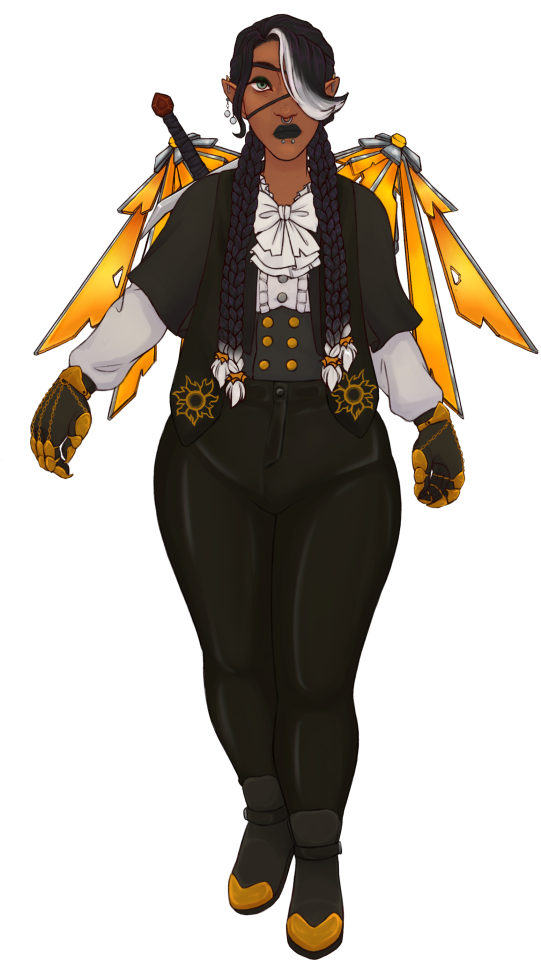
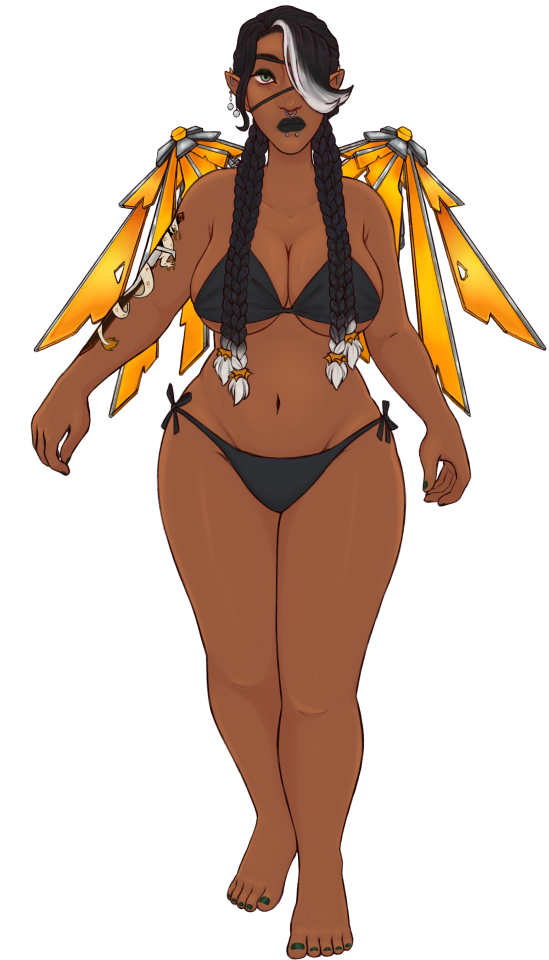
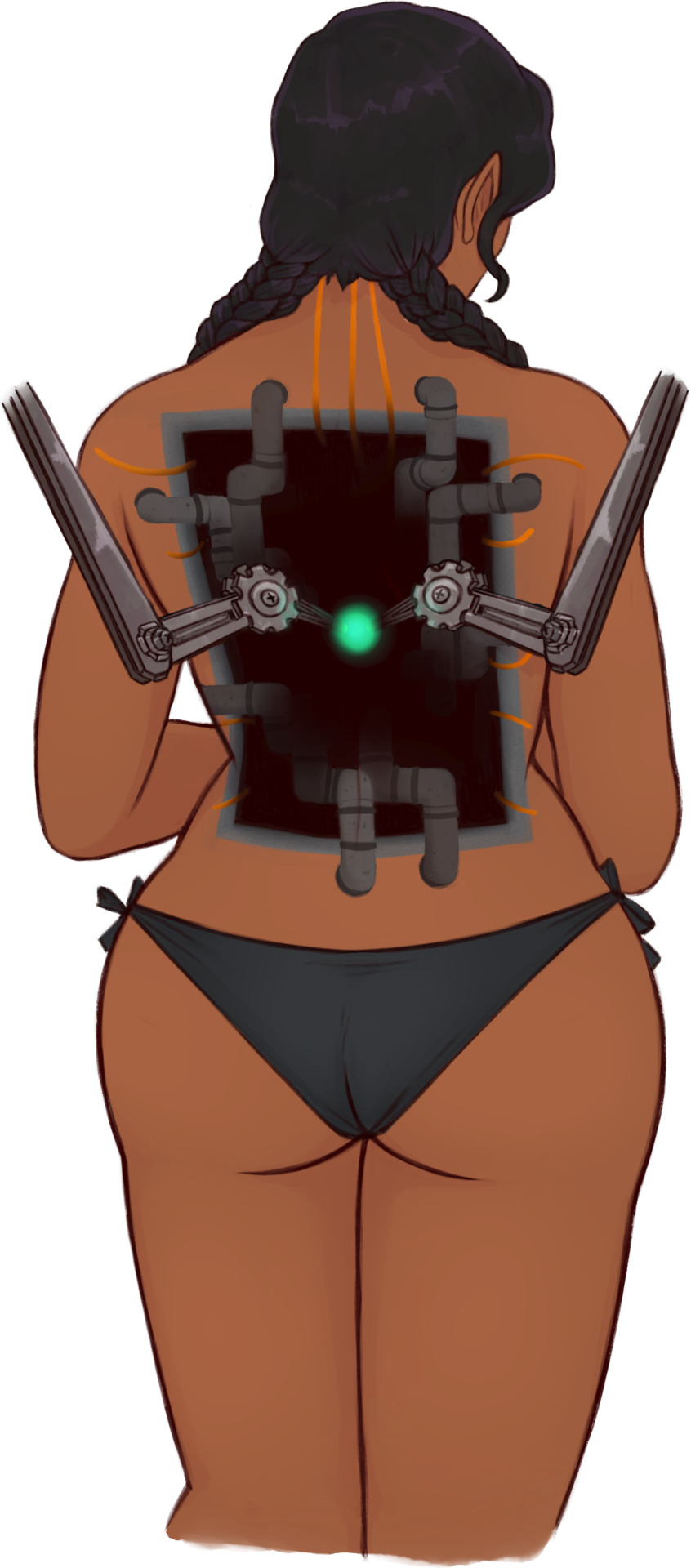
"Another of my dweebs from my original fantasy setting, Tamaz is one of a whopping 12 siblings born to King Arash Izrati II and Queen Avela Israti. Tamaz, at 29, is a prodigy of the anvil... but that's really the bare minimum expected of their bloodline, or so goes the royal line. A truly legendary enchanter and smith, Tamaz is nonetheless destined for a life of limited power among their family, so long is the line of heirs to the throne ahead of them.
The Israti city-state, Israma, is a sprawling 'utopia' some thirty-thousand people strong, and one of the most modern cities on the planet... but it comes at an incredible cost. Deep in the heart of the city dwells an ancient and powerful Demon Lord, Uzuna, who drinks deeply of the souls of prisoners, slaves and debtors being worked to death in the silver mines below Israma and spewing out magical electricity that feeds the city's grid. (Demon Lords are simply wild, malevolent spirits that have grown sapient and exceptionally powerful after consuming great amounts of negative energy. Uzuna is basically a huge ball of horrible light.)
Few know this; only the King, his immediate heir, the Queen, and a few powerful mages that the King keeps close. Tamaz, unaware and bitter at the state of their family and the city's diplomacy with surrounding populations of other species (a trait among the old human kingdoms which share some common ancestors, of which the Isratis are one of the last holdouts to be deposed) has set off to complete a religious trial and earn the 'blueprint' of the 'magical engine' that powers their city, so that they may spread it to others and shake the kingdom's position in the region.
Tamaz sets out to complete the Trial of Six Waters for the foreboding and strange God of Smithies, Tools and Waters, Thamania. Using their skills as a smith and enchanter, Tamaz seeks to construct six artifacts that will majorly shift fate in some way--positively, as they envision, but not necessarily, as they will come to learn--and cast them into six consecrated bodies of water.
Little does Tamaz know that they will do more than simply rattle their kingdom in the end, as what Tamaz will learn to forge at the end of their arduous and painful journey will reap what the kingdom has sewn, one way or another.
Personality wise, Tamaz generally seems cool and calculating. They have a relaxed charm about them, and happily engage in conversation with strangers. They, however, readily show a judgmental and arrogant side, and struggle with a need for control and occasional cruel impulses. They are, at heart, passionate and well-intentioned. They're very quick-witted and incisive, paired with a monotone ease. Lot of big sister vibes.
Sorry to go a little long, but Tamaz is one of my favorites and I wanted to give them a good showing! Some fun little details:
Uses a kickass enchanted crystalline longsword called Veilbane with which they are very skilled. It is depicted on their arm tattoo!
Has three cats named Fish (Lykoi), Lenore (Russian Blue) and Vlad (Siamese) which they love dearly.
Paints a lot. Lot of creepy industrial scenes with depthless shadows being loomed over by baleful red lights. Normal?
The 'pit' in their back is merely a magical tattoo, but the armatures for the wings do indeed move, and the glow deep within faintly roils!
Okay that's all thank you! :D
OWNED BY: Anonymous
7 notes
·
View notes
Text
Fucking armatures.
A fucking week of building up the confidence to try... and all it did is confuse me more.
It's no use to work on these other things when something as actually kinda freakin' important as animation is missing. Or at least it seems that way to me.
And by all means it makes no sense. This thing Vaartis found for me, it seemed so clear. Especially compared to Wicked Engine and Godot, or even the UFBX viewer sample.
It has six different files including the identifier m_InverseBindMatrix, each of them exactly once. Four of them are different takes on loading models in different formats and libraries, including UFBX, and all of them do the same thing: get the inverse bind matrix and store it in a more library-agnostic data structure.
A bone type that has a name, a local transform, an inverse bind, and a list of child bone IDs.
That's what I have too. Great.
So that's the part I copied last week. Then I spent the next seven or eight days building up confidence and re-reading the code to make sure I got it all.
The fifth file defines the bone type and can be ignored.
The sixth file applies the transformations. So that means only two of the six files matter here. How bad can it be?
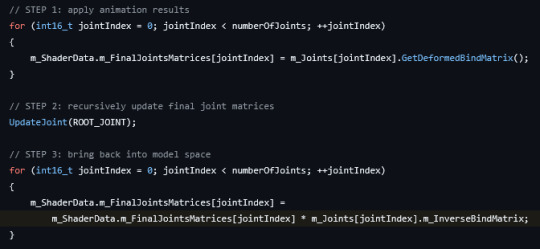
Okay so set the final matrices to the local transforms, check. So basically turning the upper arm and forearm separately.
Then in this UpdateJoint function...

Multiply the parent bone's matrix by the child's. Okay, check.
And then go through all the bones again and multiply in the inverse bind matrices for each. Seems clear enough.
So here's Project Special K's take on the above:
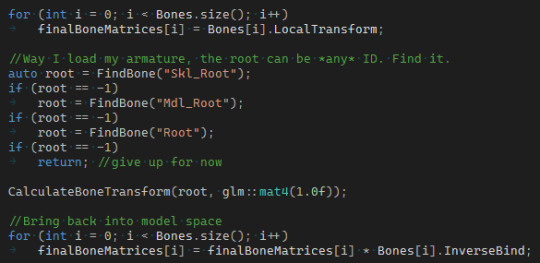
And CalculateBoneTransform is...

So here's the kicker: if I do not change any goddamn thing about a model's bones' local transforms and then recalculate, you'd expect it to give me a T-pose.
It does not. Because here's the local transform for the player's head bone and the inverse bind matrix for the same.

And the resulting final matrix?
Identical to the inverse bind matrix.
Which looks like this:

Unless I do the test thingy where I tilt the head back 45°:
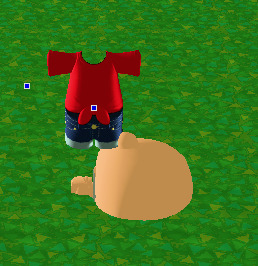
That's not even the right axis!
And if I remove the third step and don't apply the inverse bind at all things are upright, the player model certainly is T-posing, but also tilting the head back has its pivot point near the feet instead of at the neck. Which is... also no good.
I am all out of rope.
Unless someone can tell me exactly what I'm doing wrong here, I see no way Project Special K can be finished. And I'd really rather not let eighty-something people down.
Source code that only Vaartis or those with a copy of VS2015 can compile here, if it helps.
Now, if you'll excuse me, it's 00:32 and I need to get up early so I'm gonna go cry myself to sleep now.
9 notes
·
View notes
Text
A first step into the Age Of The Primes: Fugitive Waspinator

Coming to us nearly FIFTEEN YEARS later, after his original toy got canned to due the entire toyline ending, Animated Wasp finally arrives in physical form! With a slight name change, that is. Is something technically accurate if it just hasn’t happened yet…?

A redeco of Legacy United Animated Universe Bumblebee (I do not blame them for dropping the universe designations), Fugitive Waspinator comes at us in two tones of bright and dark green, and a similarly solemn purple. Despite the dark deco, this is a delightfully eye catching color scheme, really sticking out compared to his mold mate Bumblebee. Which, speaking of, Wasp looks… SO much better, gosh. I still stand by my point that the mold is a bit “chubby” and stout, but it still looks great, and especially fabulous in these colors. The two tones of green do a lot to keep things interesting, and the purple is, well, purple. It doesn’t get better than purple. More objectively, it drowns out the inner armatures and other “toy” bits that the clear plastic would otherwise show off. Any technical or color theory aspects aside, I just like how he looks, but especially compared to Bumblebee. Not to mention that head sculpt!
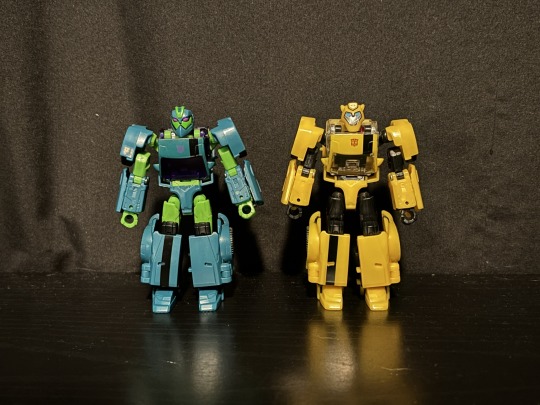
Joints and articulation are obviously the same as Bee but he maybe feels a little tighter in a few spots? The waist is a bit harder to unclip for transformation, for example. Or maybe it’s just that Bee is a year old now and the passage of time comes for us all.
Vehicle mode looks similarly splendid. He loses like, a single point thanks to the bright green of his shoulder assembly since it doesn’t come off as part of the livery like it does on Bee, but that’s such a nothing note. He’s even got a few more paint apps to make up for it. The siren is painted now, and the boosters and stingers get some additional highlights. The boosters have their fins done in silver, and the glowy bits of the stingers are painted a metallic purple instead of being the bare clear purple plastic underneath. They all look much better for it, adding an extra touch of flare that really brings it all to life.



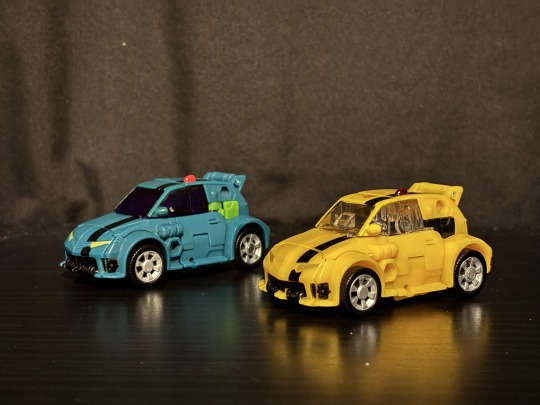
I’m not a huge fan of the blaster assembly as a weapon, but the stingers do look nice as a boost/contrail effect in vehicle mode. They’re not included as part of the package, but shoutout to these 3D printed stinger adapters. They let him use them in literally any pose that isn’t a two handed blast and ¯\_(ツ)_/¯

I’d like to mention the box really quickly, as while it does look nice and I like the new packaging style they’re going with for 2025, I must lament the complete lack of any form of bio on the back. There’s just- there’s nothing. Part of The Thing they’re doing for Age of the Primes is that each character is either a Prime (duh) or a descendant of a Prime, but that second bit isn’t reflected anywhere on the packaging. It’s mostly just something the designers have said. You’d think there would at least be a line of “ONE OF THE THIRTEEN PRIMES” or, for Wasp here, something like “DESCENDANT OF MICRONUS PRIME”, but… no. I’m not asking for full character bios or even more than a sentence, just something they could easily put on each box and have readily translated in all the different languages they print. Each part of the WFC trilogy had a packaging gimmick, and while they weren’t interesting they did have them. This wouldn’t even be a gimmick just basic flare ffs- Sell me on The Thing you’re doing right now. Please.
As a whole, Age of the Primes Fugitive Waspinator is a fantastic time, and a great example of a repaint outdoing the original. If you were interested in Legacy United Bumblebot- bee! Bumblebee, but didn’t want *another* version of the yellow menace, Wasp is a great excuse to get your hands on the mold.
3 notes
·
View notes
Text
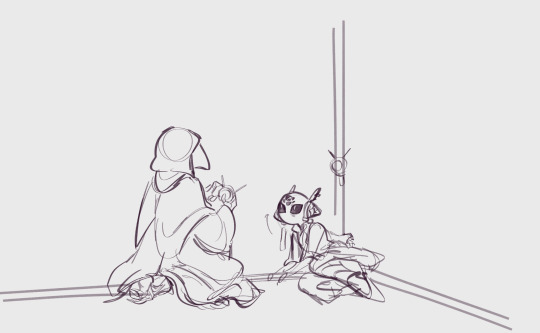
Series of Drawings for a scene I wrote in RP. I'll archive it here, I guess. Obviously this scenario applies to RP Canon, but the characterization is broadly accurate, I feel.
Content Warnings for injury and implied blood. also mentions of memory manipulation and generally emotionally intense content. probably some emotional abuse.
For some basic background, TWR was fucking around (as she often does) and found out (as she sometimes does). She was kind of bullying some random user on a chat line (as she often does) except this user happened to be particularly emotionally and physically fragile and her systems suffered an injury because of Thorns' callous remarks. Said user was under the care of someone named Endless Golden Coils (EGC), who was trying to repair her. He got very mad and did a video broadcast with Thorns where he kinda broke her because he appeared in his Guardian form and that opened up an old wound in Thorns' psychological state. So the Director is here to check in on her. ^^
---
When the Director arrived at Thorns Without Roses' chamber, they found the titular unit curled up in the corner of the room. Her umbilical wires were still on the floor, and the chamber's puppet arm had been severed before the point of connection. Part of the armature was still attached to Thorns' puppet; she had not taken care to remove it. The Director reasoned that they could fix the armature later. First, they needed to speak with TWR and assess her condition.
TWR: "Director... Is that... you?" Thorns asked, raising her head.
NCTG: "Yes," they replied, kneeling down in front of her. Their voice was low and steady, masking their current trepidation. They needed to focus on their creation. "How is your status?"
Thorns Without Roses pushed herself into a similar kneeling position, clutching the fabric around her chest.. She looked the Director in the "eyes" as she spoke.
TWR: "I... I am unwell, Director. I-I am defective. Please reset me."
Thorns Without Roses was smiling, for some reason. And she was asking them to "reset" her. That wouldn't do. It was... tempting, admittedly. But Endless Golden Coils was doubtlessly seeking atonement, not just reformation, and resetting Thorns would allow her to escape that responsibility. EGC would certainly be upset. And they couldn't have that.
...And, of course, it would upset her fellow Assistants, too. That wouldn't be very good, would it? Further, it would compromise their ideals. They favored free will, after all. Really, these were all important, pressing reasons not to reset her.
"I cannot do that, Thorns Without Roses," they replied carefully. "It would not be right of me to do so. Please understand."
Thorns' smile faded, and her pupils shrank. She began to tremble.
TWR: "Director... Director, please. You... Y-You must..."
Thorns Without Roses fell silent, clutching the fabric on her skirt. She stared at her hands.
Eventually, she looked back at the Director and spoke once more.
TWR: "Can you delete the memory of the encounter, at least? It... would not do me well to remember."
The Director shook their head.
NCTG: "I apologize, Thorns, but... I cannot do that. Please understand. You must appease Endless Golden Coils. And I have faith in you. I am certain that you are capable."
TWR stared at them for a while, trying to analyze their words.
"I am certain you are capable." The sentence stuck with her, much like EGC's earlier decree. The Director believed in her. Thought she was worthy of the task that had been assigned to her. That esoteric, bewildering task...
"All you have to do... is be nice."
But the Director was wrong. If there had been any trait that she had repeatedly failed to display, it had been kindness.
Perhaps the Director might teach her.
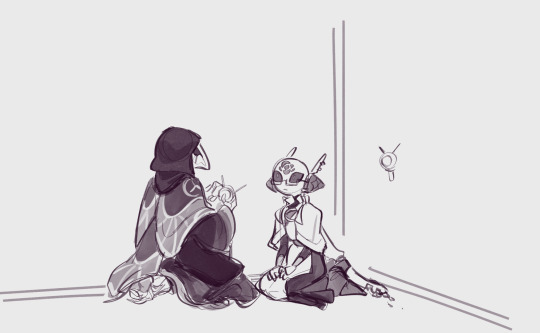
The Director, meanwhile, grew concerned. Thorns Without Roses was not responding. Was she alright?
She grabbed onto them.
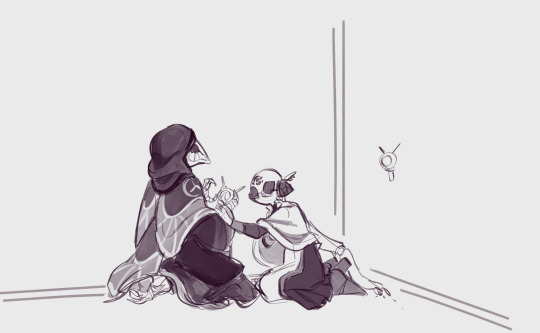
TWR: "No... you... you have to fix me, Director... I-I am not capable. You must fix me," Thorns repeated.
NCTG: "I—I am going to fix you, Thorns. I am going to repair the damage to your chamber. Please calm down. You are going to be alright."
TWR: "No, you have to fix me, Director. I am erroneous. You must erase my memory."
Thorns Without Roses eyed the ID drone. The Director quietly swapped the drone to their other hand.
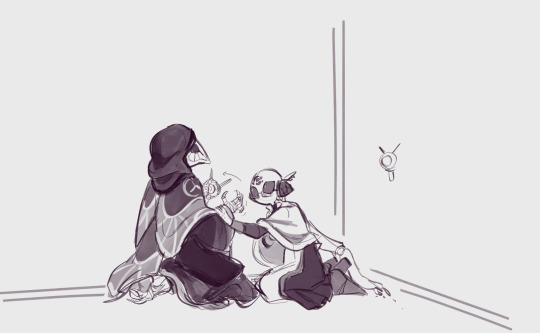
NCTG: "Thorns. Please, you must calm down. You are behaving erratically. You—"
TWR: "That's why you need to fix me, Director! You must correct the error in my programming!"
Thorns was shouting now, bringing down the Director's arm. She reached out for their ID drone. Quickly, they raised the arm holding the ID drone. They attempted to raise their other arm alongside it, but Thorns' grip was too strong.
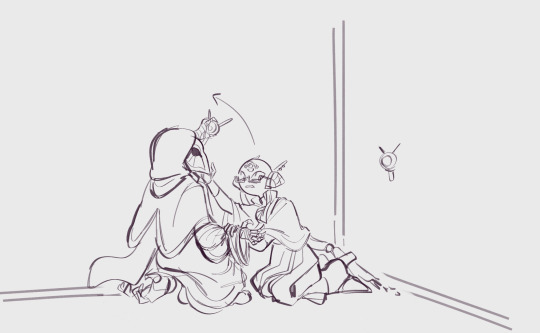
TWR: "Director!" She cried. "Why are you doing this? I need you to erase those memories. Do you hate me? I know that I'm defective, but please...!"
The Director struggled to keep the drone away from her.
NCTG: "Thorns. Thorns, let go of me! Stop that. Let go of me. I-I command you."
They weren't quite in a position to operate the drone just yet. They'd have to get through to her first.
NCTG: "That is an order, Thorns Without Roses."
Thorns Without Roses did not relent. Instead, she used both her arms to bring the limb within her grasp closer to the ground.
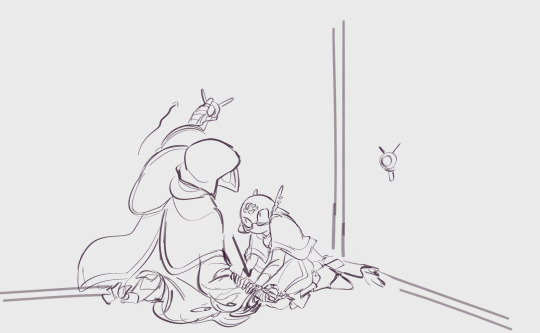
The Director lost their balance for a moment, but they quickly straightened themself out and resumed holding the ID drone away from Thorns. This was not going well.
NCTG: "Thorns, you need to listen to me. This is an order. I am ordering you to—"
But Thorns did not listen. Her movements became desperate and animalistic; her instincts had taken over. There was an issue, and she needed to correct it. With an unprecedented force, she pinned the Director's arm to the ground and planted her foot atop it, keeping it in place as she leaned forward for the drone.
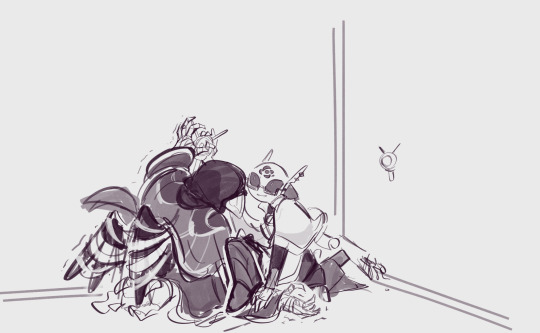
There was a terrible crack. No Cost Too Great could feel a great pain in their right arm, now incapable of movement. Their wings slipped from their bindings. The drone was pried from their grasp as they let out a terrible screech.
Thorns was grinning wildly. She had done it. Now she just needed to figure out how to operate the thing. It couldn't be that hard.
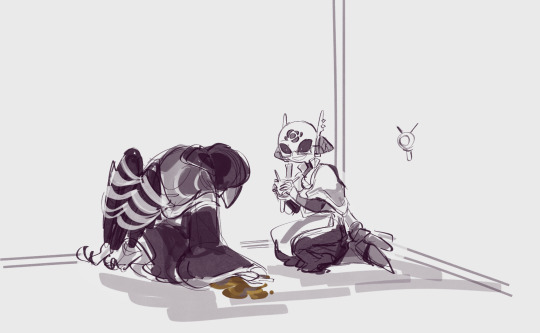
Golden blood pooled from the injury. The Director was still reeling from the impact. They'd have to re-bind their wings, and then they'd have to fix their arm, and...
Thorns discovered that the drone, unfortunately, did not respond to her inputs whatsoever. It was impossible to progress any further in this state. She still needed her Creator's help.
TWR: She presented it to them. "Director, I cannot seem to operate this. You must help me. I need to fix myself."
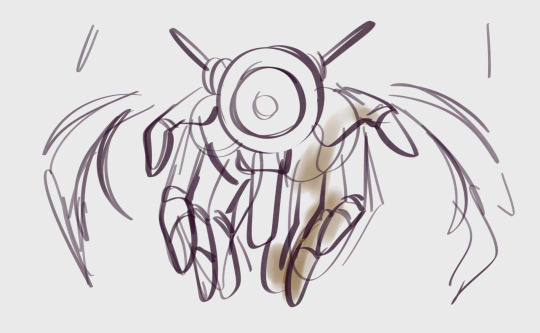
The Director interrupted their musings about their injuries to look at Thorns again. Clearly demented. But, she seemed to be relying on them, at least for the moment. They took the ID Drone with their left hand and set it in front of them. Awkwardly, they navigated to the "deactivation" button.
TWR: "Thank you, Director. I am indebted to you." She smiled at them, relieved.
They deactivated her.
The Director, finally, took the time to assess the damage. There was no doubt about it; the intricate bone structure they'd taken such great care to instate had shattered. They'd have to fix it with surgery later, or else their limb would reform in some terribly abnormal matter... Supported by that disgusting, cartilaginous substitute for a proper skeletal system. It was nothing short of infuriating.
And then there was the blood. They had to clean everything up and fix their creation's chamber, all with the use of one arm. In hindsight, they'd been terribly thoughtless about the whole endeavor. Perhaps the absence of the Global Council had dulled their sense of reason.
Another voice cut in suddenly, broadcasted from a seafoam-green overseer.
SGIS: "Are you alright, Director!? What happened?"
Their thoughts were beginning to congeal into a hazy sludge. They regarded the overseer with a subdued confirmation.
NCTG: "I... I am fine. The injury will heal on its own, and I can fix it properly once I get back. Thorns is deactivated for the time being. It is unfortunate, but I fear a rest cycle might... Might, um...."
They groaned.
NCTG: "You know, ah..."
Damn, it hurt. They hadn't remembered a broken limb being this painful. Of course, they hadn't broken a limb since before the mass-ascension, and even then, it was quite a long time ago...
SGIS: "You... You do not sound alright, Director..."
NCTG: "I'll be fine," they hissed. "I just need to use a bit more painkiller. And then figure out... What to do with Thorns. And then..." They stood up, scanning the room.
They needed to contact Endless Golden Coils, first. It was imperative that they confirmed his demands. The lost blood would regenerate itself soon enough.
SGIS: "Director, you must bandage the wound. You need to suppress the blood loss," she urged them.
No Cost Too Great sighed, doing their best to gather the bindings on their wings that had come loose. They realized, with great frustration, that it would be terribly difficult to re-apply their bindings in this state. They shifted their goal. Near the chamber's entrance sat a first aid kit, situated next to their (now barely usable) maintenance equipment.
NCTG: "Right. I'll go get some bandages," they announced.
SGIS: "Thank you, Director." The relief in her voice was palpable.
No Cost Too Great felt around for a roll of bandages from their first aid kit. Most of their supply served more for binding than for closing injuries, but they inevitably fished out something suitable.
They unraveled the messy bindings around the injured arm as best they could, using their mask as a makeshift "beak" when needed. Soon enough, they uncovered the injury, contorted and ripped apart, weeping that sickening golden liquid. A few stray feathers fell out with the scraps.
How unsightly.
SGIS: "A-Are you alright, Director?"
NCTG: "I'm fine," they whispered hoarsely. "It's not the worst thing I've ever seen. I'll get to bandaging it.
SGIS: "...Right. Good luck, Sir."
They utilized their mask to pry open the adhesive contraption. It looked rather ridiculous, they imagined, but it couldn't be helped. Carefully, meticulously, they wound the bandages around their arm, burying their repulsive anatomy under layers of cloth. The finished result was... suitable enough.
SGIS: "Ah," she gasped. "I... I just realized. You should have used some kind of splint to keep the arm in place."
The Director looked up at the overseer for a moment, and then back at the first aid kit. They were rather certain they hadn't prepared anything like that within it. There may have been something within the maintenance supplies, or perhaps they could have used one of the medication containers...
But they were too tired to care right now, really.
SGIS: "I'm sorry, Sir. I... I didn't think it through. I should have better considered the situation."
NCTG: "It's fine," they hummed. "I'll just... Fix it later, I suppose. And the blood should replenish itself soon enough. In the meantime, I'll... Only have some minor cognitive impairment to worry about." They reached for a container of painkiller, only to put it back. It would be rather difficult to administer in their current condition.
SGIS: "Sir... Oh. Hang on. You know Whispering Paracosm, yes? Thorns Without Roses' group-mate?"
The Director shrugged noncommittally.
SGIS: "Yes. They are a medical facility. Shall I contact them to fetch you a drone?"
NCTG: "I said it is fine," they replied brusquely. They acknowledged the potential usefulness of a medical drone, of course, but they saw no reason to bring further attention to their current instabilities. They could resolve these issues on their own, just as they had always done.
There was a long pause. Inevitably, Seafoam spoke up again.
SGIS: "Sir. I... Understand that this may be demoralizing, but you are badly injured. Please accept medical assistance. I am aware that your... unique condition allows you to heal rather quickly, but won't it be easier if you can fix things now instead of later?"
...It was a reasonable argument to make. No Cost Too Great winced. Such obstinance was unbecoming of them, really.
NCTG: "Alright. Have them send a drone over," they sighed.
SGIS: "Of course. Thank you, Director."
---
It continues, of course, but it's no longer exclusively my writing, and... I don't really want to archive an entire series of scenes, haha. I wrote / re-wrote some portions at the end there to facilitate a more natural cut-off point. I also touched up the writing in general, as I tend to do...
Extra Context: Whispering Paracosm is my friend Casper's OC. In RP Canon (Pline), they're one of TWR's Groupmates! In main MIP Canon her groupmates are POE and uhhhhhhhhhh wow that's crazy. I have no idea... teehee. I'm sure it probably doesn't matter. Maybe. Ehhh I'll figure it out ~
anyways after this Director ended up going to WP for medical treatment and eventually TWR went to Flowering Salvation for therapy. and Whisper helped her too. the root cause of her trauma with metaphysical fuckery was not really super addressed but it's okay because Thorns eventually kinda went back to normal anyways. and now she can return to bullying people for fun ((as long as EGC isn't there.))
#the vault#dec 2024#sensitive content#pline canon#mip vignettes#thorns without roses#no cost too great#seafoam glimmering in sunlight#nonmips#endless golden coils#mip character building#mip interactions#luna's art#mipdoodles#mip 1.5#mip units#mip architects#implied blood
4 notes
·
View notes
Text
ok does ANYONE have any info/guides on 3d freehand embroidery? I don't mean raised stuff on fabric, im trying to make a full moth with articulated wings that can be held in my gay little hands. i have ideas but it'd be cool to see what other people are up to, but i can't find basically anything
i know this is ambitious but im confident in my embroidering at this point so 👍 the plan is to stitch all four wings separately onto felt with armature on the back, and then the body that ill then sew closed with some fiberfill so it has volume. and then put everything together and whip stitch the edges. but that's so so so scary
6 notes
·
View notes
Note
Hey Soul! Have you read the ‘Project Regen Files’ by Quiet_Shadow on AO3? I’d think you’d love it. It’s basically a ‘what if’ series about if the TFA Decepticons had won and conquered cybertron, the twist being that they regressed the Autobots back to their ‘proper’ spark age (the younger ones like OP, Bee, and Bulkhead mostly being turned into sparklings while the older ones like Prowl, Ratchet, and Ultra Magnus were turned back into younglings/young adults.) and are adopted by Decepticons and are given ‘proper’ childhoods by them.
A question if mine would be; how would TFA Megatron’s human kid react to all this? One minute their fighting with their friends team prime to save Earth and Cybertron from their recently discovered bastard tyrant of a biological father and than the next thing they know, they’re waking up on Cybertron - a Deception ruled one at that! - and from the news they’ve gathered, their friends had been turned (back?) into babies! Now they’re wondering and on the brink of a panic attack about what Megatron and his thugs have done and will continue to do. A main question that keeps their great pounding and their mind spinning is; what is he going to do to/with me?
Oh, yeah, I read it. I got hope they'll update it since they're still active in the fandom. I actually had a draft of a continuation with TFA!Ratchet and his Cybertronian SO where they're dealing with a Decepticons!win scenario where that happened. Now Ratchet is a young man with a young sweetspark (they were worried about their spark-bond since they've been together that long) under new management, and suitors at their door since he's a medic and the SO has a lineage that intrigues some Decepticons.
Slight deviation here: Sari is Megatron's kid. Because, c'mon, it fits so well~!
All Megatron's are territorial, TFA is no exception with his bougie aft. He would definitely fetch his wayward daughter, and he isn't above using threats to coerce her.
Sari has a Cybertronian alt-mode, but her father...
In exchange for going with him, Dr. Sumdac gets to live with his ill-gotten company and Earth will be left alone since Cybertron is the jewel of his achievements
To sweeten the deal, Megaton even dangled a few newsparks of her friends. He ensured that they'd be well-cared for with those trusted.
Optimus becomes her new brother since Megatron isn't letting the Prime that almost bested him go out of his sight. A little maintenance bot with far more courage and ball-bearings bestowed by Unicron nearly got the Slag-maker himself! He's curious to see what will happen with proper guidance.
Megatron has his work cut out for him. There's no way he can simply unwind and relax. Oh no, now the real work begins with reconstruction, subduing rebellious forces within the population, and transporting Decepticons back to their homeworld. Made more stressing now he has young bitties with him.
He can appreciate how spirited Sari is, especially as she digs her blunt digits into his seams as he takes her for a proper check-up. He'll eventually teach her how to access her talons.
Not happy about the state of health, but not surprised either. Dr. Sumdac was only a human and merely addressed her humanity.
Sari is critically low in essential metals and minerals, especially as a war-frame sparkling. Megatron has no idea where the yellow comes from, but her armature is supposed to be thicker, her frame larger with more coverage.
He severely dislikes the blue disc upon her chassis. She doesn't have the skill nor the experience to taunt her opponents like that.
Her weapons systems are far more advanced in development...
Due to the lack of so much, her growth prioritized a more slender, speedier frame and jacked-up her weaponry for defense since she didn't have any half-decent caretaker.
Optimus is at least in decent health. A surprise, considering the reports coming in about the remaining adult Autobot population. He does quite a set of vents on him.
The Decepticons don't regress every single 'bot. There's too much critical infrastructure they don't understand or need hands-on to maintain.
The warlord will make a creator-bond with them. It's only a matter of time. Their frames will fall to their biology.
Newsparks seek out creators to soothe their immature sparks and basic emotional needs. They need an adult to lull it back to parameters. Optimus is no different now. Blind, confused, and terrified. Unlike the 'bots that were reversed to their young adult or mechling phase, newsparks are too underdeveloped to retain their adult memories. Their bodies are ruled by instinct.
Optimus had initially fussed and wailed, but with time, care, and close contact had soothed him to burble happily in Megatron's arms.
Sari, however, is a war of attrition between her sparkling frame's needs and her fostered human independence.
If anyone were to see meal times in the newly created High Lord Protector's household, there's a patient Megatron spoonfeeding Optimus and a Sari mullishly picking at her own plate. It becomes a common conversation that it isn't poisoned. Enhanced with nutritional boosters and supplements, but nothing designed to kill.
Megatron is deeply unamused over the argument of maturity. He doesn't care that she's a teenager on Earth. Sari, by Decepticon laws, is a sparkling that's not even close to a mechling (adolescent).
Even accounting her techno-organic status and her "upgrades," the basic readings of her spark energy clearly puts her as a young child of his species.
Because of the sheer range of her abilities, Sari has a power inhibitor on her. The last thing anyone needs is for her to disappear in the middle of the upheaval and restructuring, especially with newsparks she has no knowledge to care for.
Sari didn't even know Cybertronians could have the equivalent of babies. She still remembers Optimus' confused distress over her blunt explanation.
It was one of the major points that drove Cybertron to war before the schism as the Senate tried to impose "sticter frame-schematics regulations to ensure greater workforce efficiency."
There seems to be a great discrepancy between the Autobots and Decepticons beyond size and flight capabilities. Megatron wasn't imagining things: the little cretins aren't as durable as before.
Many of his generals (and himself) had assumed that the Autobot military were attempting to mimic their civilian-frames over the eons. The fools didn't even realize they severely compromised the core-programs by all the extensive modifications of their own frame-schematics.
The compact size allowed Autobot High Command to throw all the available resources into their research, but impacted their life expectancies and immensely increased health complications.
When the extent of the damage was realized, Megatron swore in his office and had to order a new desk. New plans and interventions needed to be made...
Sari spends a lot more time in Optimus' nursery. Between a choice of Megatron or a baby, she rather have spit-up down her armor.
Maybe it's hope, no matter how vain it is, that Optimus remembers because he seems to blindly reach for her.
But it's different. The adult-Optimus always had a field that curled carefully around hers whenever she used her bot-mode. A steady, warm presence like a friendly hand on her back. Baby-Optimus spikes against hers. He tugs and yanks until he's fully buried in her, blanketing deep into her field as he nuzzles her neck.
Sari has to admit, he's a pretty baby with his bright colors and chubby face. It's super cute when Optimus' antennae flicks.
She whispers to him updates on the rest of the team. How Bumblebee and Bulkhead are a pair in Lugnut's and Strika's huge hands, that Prowl is under the care of a mech called Barricade, the twins went to Shockwave, and now Ratchet is a young mech with a chipped chevron that's still as grouchy as ever.
#ask#transformers#transformers animated#tfa#megatron#sari sumdac#optimus#optimus prime#deaged#parental relationship#bitlets#sparklings#cybertronian culture#cybertronian biology#tf headcanons#maccadam#my writing#megs pours himself a glass of oil wine because of his kids
66 notes
·
View notes
Text
I have spent the last few weeks overhauling my ProtoBear VRC avatar, which also included all the public versions I had made.
But I also decided that it was finally good enough for me to make into a base and release into the wild. It is very basic, since it was only the 2nd avatar I ever made, I just cleaned it up a lot, re-did the UV's, fixed up some weights, adjusted the armature, then had to re-make the materials and physbone setups in Unity.
But I'm very happy with how it came out.
[Drive folder link here]
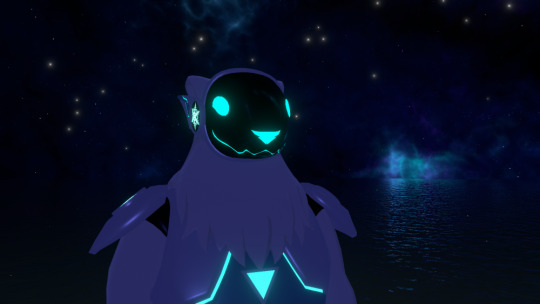

Currently it does not have a Quest version, I need to re-visit that as well at some point, but in the meantime you can always generate impostors yourself. :)
Happy beeping!
2 notes
·
View notes
Text
Data Engineering Concepts, Tools, and Projects
All the associations in the world have large amounts of data. If not worked upon and anatomized, this data does not amount to anything. Data masterminds are the ones. who make this data pure for consideration. Data Engineering can nominate the process of developing, operating, and maintaining software systems that collect, dissect, and store the association’s data. In modern data analytics, data masterminds produce data channels, which are the structure armature.
How to become a data engineer:
While there is no specific degree requirement for data engineering, a bachelor's or master's degree in computer science, software engineering, information systems, or a related field can provide a solid foundation. Courses in databases, programming, data structures, algorithms, and statistics are particularly beneficial. Data engineers should have strong programming skills. Focus on languages commonly used in data engineering, such as Python, SQL, and Scala. Learn the basics of data manipulation, scripting, and querying databases.
Familiarize yourself with various database systems like MySQL, PostgreSQL, and NoSQL databases such as MongoDB or Apache Cassandra.Knowledge of data warehousing concepts, including schema design, indexing, and optimization techniques.
Data engineering tools recommendations:
Data Engineering makes sure to use a variety of languages and tools to negotiate its objects. These tools allow data masterminds to apply tasks like creating channels and algorithms in a much easier as well as effective manner.
1. Amazon Redshift: A widely used cloud data warehouse built by Amazon, Redshift is the go-to choice for many teams and businesses. It is a comprehensive tool that enables the setup and scaling of data warehouses, making it incredibly easy to use.
One of the most popular tools used for businesses purpose is Amazon Redshift, which provides a powerful platform for managing large amounts of data. It allows users to quickly analyze complex datasets, build models that can be used for predictive analytics, and create visualizations that make it easier to interpret results. With its scalability and flexibility, Amazon Redshift has become one of the go-to solutions when it comes to data engineering tasks.
2. Big Query: Just like Redshift, Big Query is a cloud data warehouse fully managed by Google. It's especially favored by companies that have experience with the Google Cloud Platform. BigQuery not only can scale but also has robust machine learning features that make data analysis much easier. 3. Tableau: A powerful BI tool, Tableau is the second most popular one from our survey. It helps extract and gather data stored in multiple locations and comes with an intuitive drag-and-drop interface. Tableau makes data across departments readily available for data engineers and managers to create useful dashboards. 4. Looker: An essential BI software, Looker helps visualize data more effectively. Unlike traditional BI tools, Looker has developed a LookML layer, which is a language for explaining data, aggregates, calculations, and relationships in a SQL database. A spectacle is a newly-released tool that assists in deploying the LookML layer, ensuring non-technical personnel have a much simpler time when utilizing company data.
5. Apache Spark: An open-source unified analytics engine, Apache Spark is excellent for processing large data sets. It also offers great distribution and runs easily alongside other distributed computing programs, making it essential for data mining and machine learning. 6. Airflow: With Airflow, programming, and scheduling can be done quickly and accurately, and users can keep an eye on it through the built-in UI. It is the most used workflow solution, as 25% of data teams reported using it. 7. Apache Hive: Another data warehouse project on Apache Hadoop, Hive simplifies data queries and analysis with its SQL-like interface. This language enables MapReduce tasks to be executed on Hadoop and is mainly used for data summarization, analysis, and query. 8. Segment: An efficient and comprehensive tool, Segment assists in collecting and using data from digital properties. It transforms, sends, and archives customer data, and also makes the entire process much more manageable. 9. Snowflake: This cloud data warehouse has become very popular lately due to its capabilities in storing and computing data. Snowflake’s unique shared data architecture allows for a wide range of applications, making it an ideal choice for large-scale data storage, data engineering, and data science. 10. DBT: A command-line tool that uses SQL to transform data, DBT is the perfect choice for data engineers and analysts. DBT streamlines the entire transformation process and is highly praised by many data engineers.
Data Engineering Projects:
Data engineering is an important process for businesses to understand and utilize to gain insights from their data. It involves designing, constructing, maintaining, and troubleshooting databases to ensure they are running optimally. There are many tools available for data engineers to use in their work such as My SQL, SQL server, oracle RDBMS, Open Refine, TRIFACTA, Data Ladder, Keras, Watson, TensorFlow, etc. Each tool has its strengths and weaknesses so it’s important to research each one thoroughly before making recommendations about which ones should be used for specific tasks or projects.
Smart IoT Infrastructure:
As the IoT continues to develop, the measure of data consumed with high haste is growing at an intimidating rate. It creates challenges for companies regarding storehouses, analysis, and visualization.
Data Ingestion:
Data ingestion is moving data from one or further sources to a target point for further preparation and analysis. This target point is generally a data storehouse, a unique database designed for effective reporting.
Data Quality and Testing:
Understand the importance of data quality and testing in data engineering projects. Learn about techniques and tools to ensure data accuracy and consistency.
Streaming Data:
Familiarize yourself with real-time data processing and streaming frameworks like Apache Kafka and Apache Flink. Develop your problem-solving skills through practical exercises and challenges.
Conclusion:
Data engineers are using these tools for building data systems. My SQL, SQL server and Oracle RDBMS involve collecting, storing, managing, transforming, and analyzing large amounts of data to gain insights. Data engineers are responsible for designing efficient solutions that can handle high volumes of data while ensuring accuracy and reliability. They use a variety of technologies including databases, programming languages, machine learning algorithms, and more to create powerful applications that help businesses make better decisions based on their collected data.
4 notes
·
View notes
Text
Transformers: Devastation #5
you won't believe it's this much of an anticlimax!
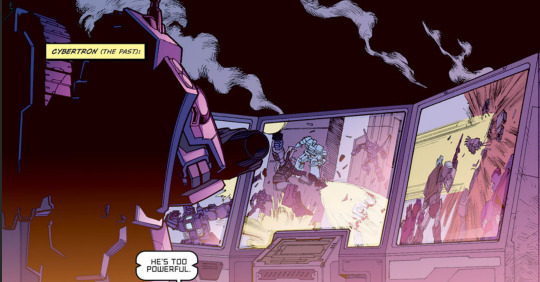
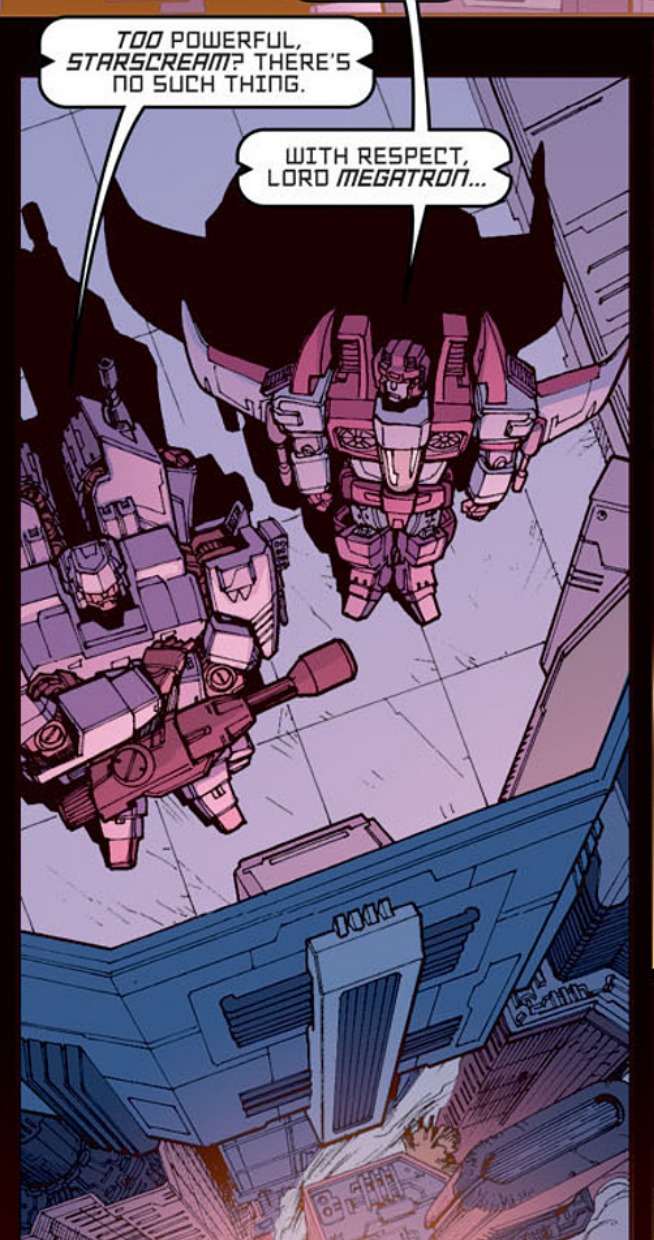
Starscream talks about how it's his duty to protect Megatron (that it's his sole duty, in fact) and that he doesn't think he could protect him from Sixshot
Megatron calls him "alarmingly naive" and says, firstly, his presence is mostly for show, and secondly...do you really think he'd have a living weapon...
"if i did not have the offswitch?" also this dynamic is wild
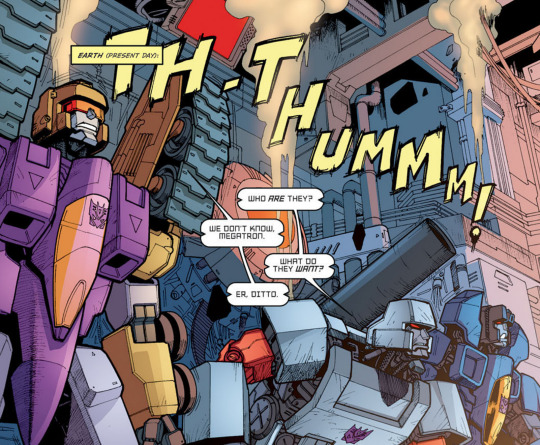
Megatron demands Blitzwing tell him something or he'll eviscerate him like Starscream
Blitzwing: um. they're…alien. a mishmash of species. and they're, er…
Blitzwing:...hostile
all of the Reapers are attacking the fortress at once
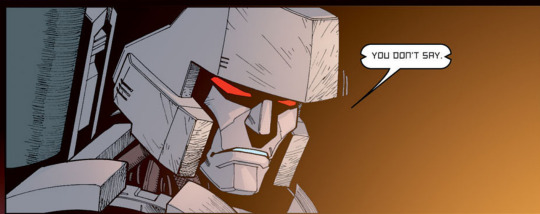
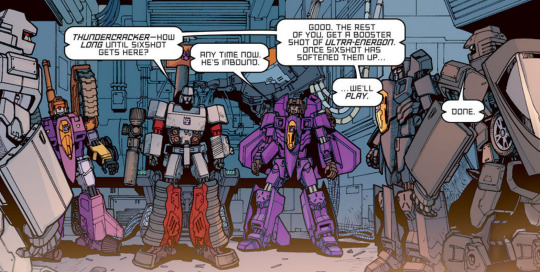
Thundercracker, you're very purple today
Megatron asks Blitzwing where Astrotrain is
Blitzwing panics for a sec before recovering himself and saying that he's aligning the orbital defences because he thought they'd need the firepower
Megatron says at least one of them isn't a complete waste of space, blah blah, have him report when he's done
Blitzwing slips off
over to Astrotrain, someone is telling him he'd better go
Astrotrain: but when-
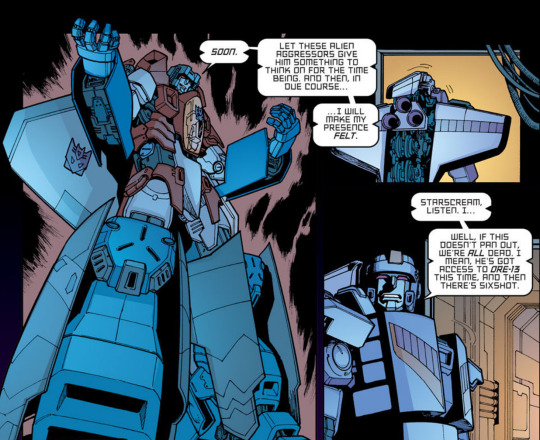
i just love these dynamics so much also wish Blitzwing had had a bigger role
Starscream tells Astrotrain to relax and that with Sixshot it's simply a matter of turning offence...to defence
Sixshot is coming in
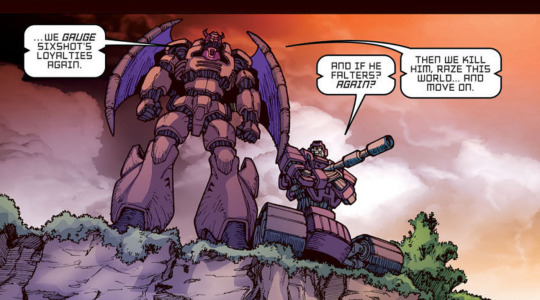
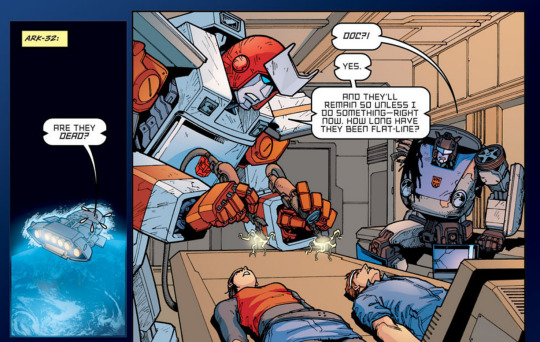
nearly 6 Earth minutes. Bad. Ratchet is worried about brain damage
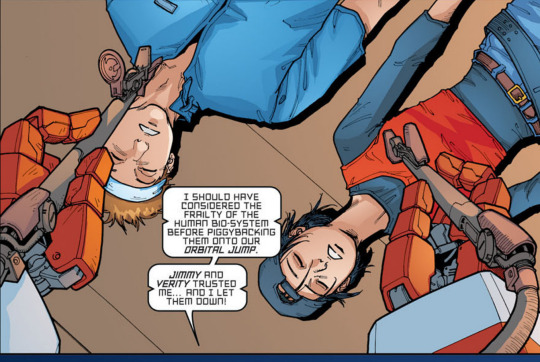
Ratchet shocks them and they stop flatlining
anyways time for jazz to be fixed now
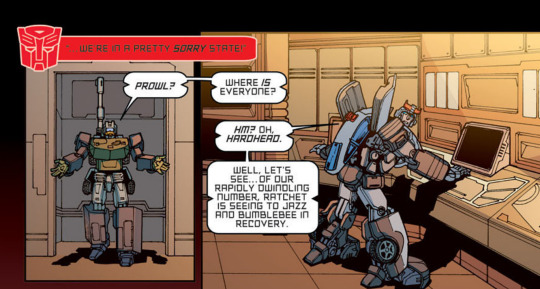
Prowl: Nightbeat is straight back to whatever Nightbeat does
he's looking at some kind of analysis
Prowl: and Optimus is dealing with some kind of crisis
Optimus is listening to a recording about Jhiaxus
so it just leaves Prowl and Hardhead
Hardhead wonders about Hot Rod and Wheeljack
Prowl figures they sent an update at some point but right now it's pretty low on their priority list

wheeljack actively loses braincells working with hot rod only explanation
Wheeljack agrees, and then suddenly a bunch of cars fall on him, burying him!
he sends an SOS to Hot Rod who turns around to go back and help him but-
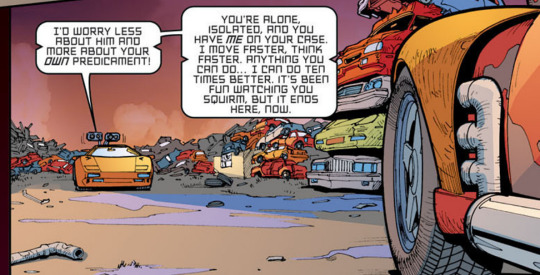
cars vs cars surrounded by cars
Hot Rod revvs repeatedly and very loudly
and basically just says "bring it on!"
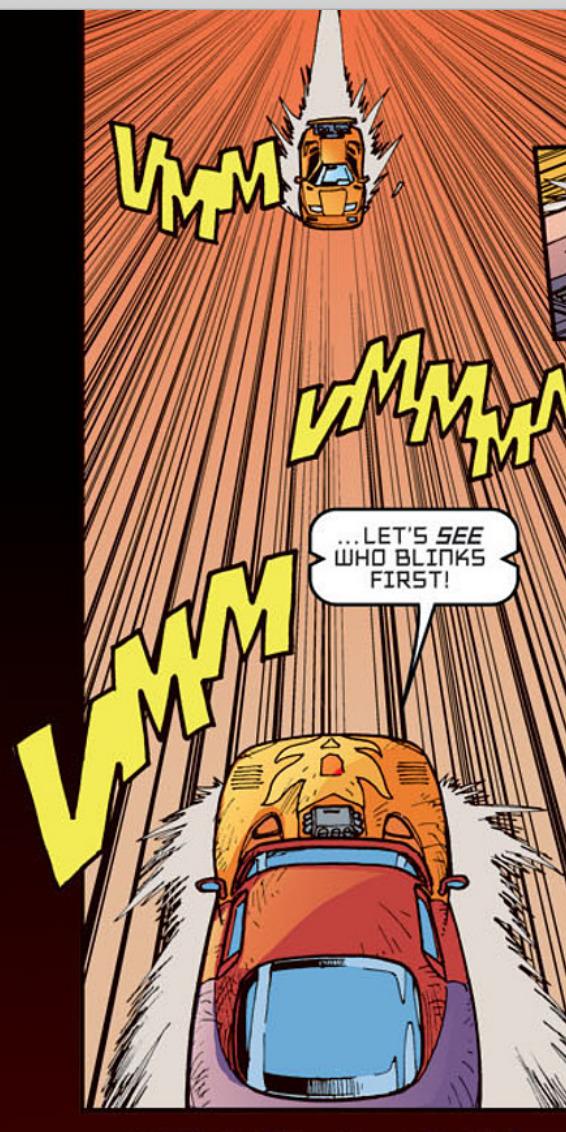
im sorry i cant take them revving at each other seriously
Headmaster dude ends up flipping end over end and breaking apart into a pile...of parts
Hot Rod: amateur
but oof, there's the other two and they're firing at him
and now time for the horror duo
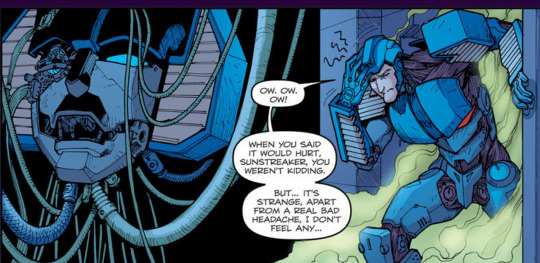
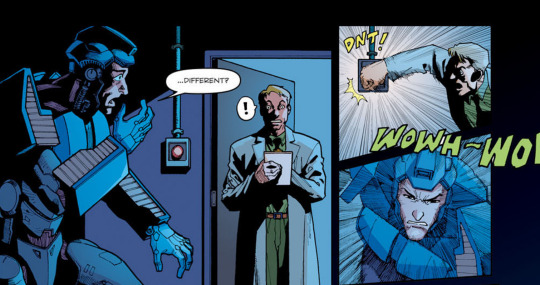
Hunter punches him and the guy gets thrown across the hallway into the wall
Hunter then stares at his hand in disbelief and wonders if that was him or Sunstreaker
but one thing he knows for sure...
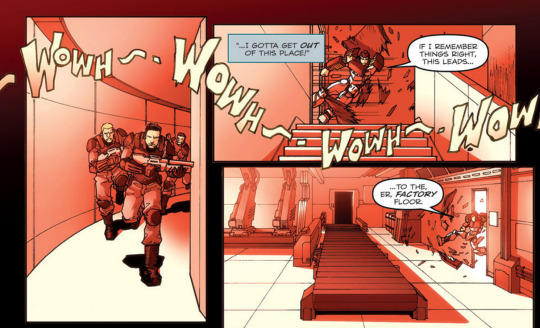
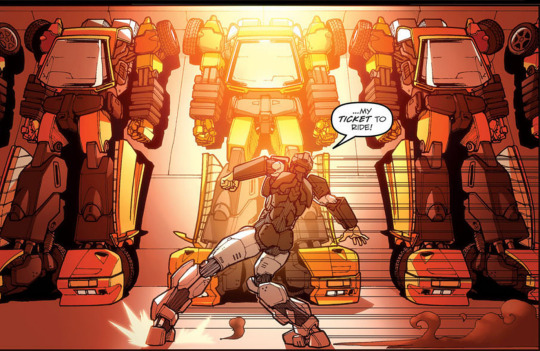
man that was a satisfying punch probably for both of them and now, back to oregon
Sixshot once again refuses the Reapers, and fires at them
"Then what, pray tell..."
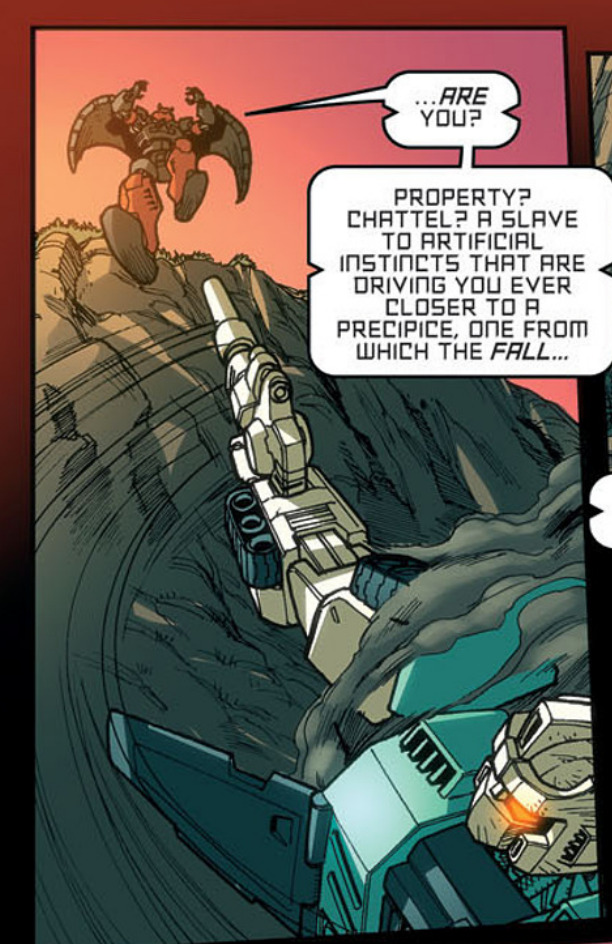
see this? this is a good shoulder devil
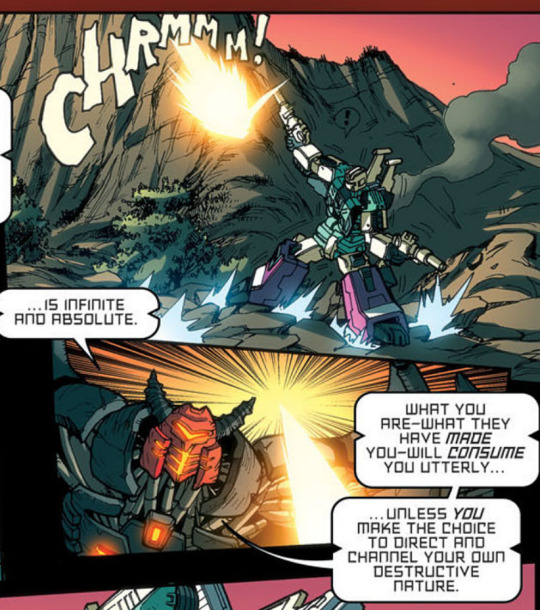
Sixshot goes wolf mode
"Join us in our crusade to end war, or die here, now!"
"for all your devastating power, we…are legion"
he talks about how this world needs to be put out of its misery, turn the mania that eats at your very soul into a mercy
Sixshot pauses
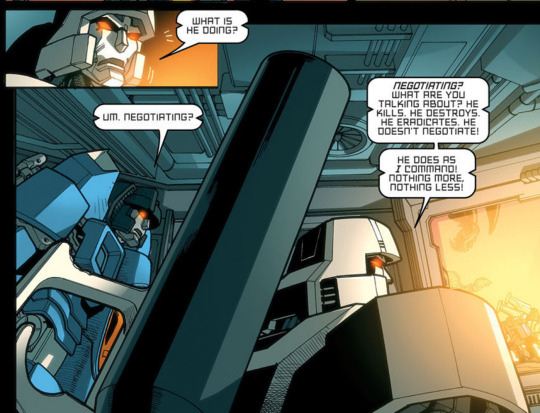
Runamuck (??? the black twin) turns to Megatron and tells him someone's opened the main siege armature
"Sixshot!"
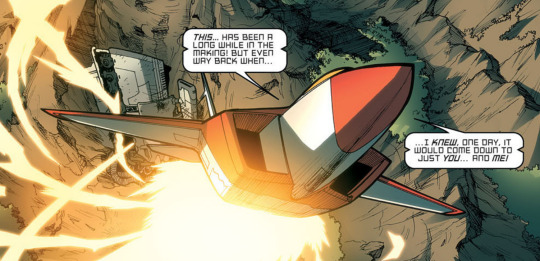
Megatron is shocked at Starscream, meanwhile Reaper Guy tells Sixshot it's now or never!
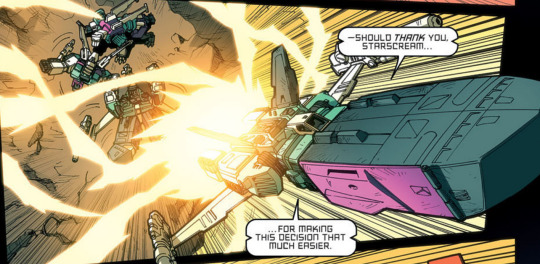
now that's pettiness
Sixshot: any last words?
Starscream: as it happens, yes
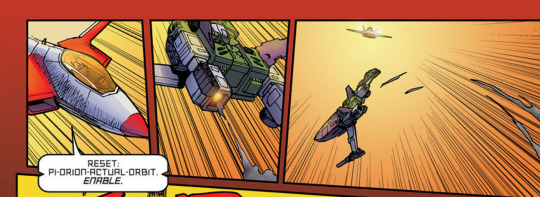
welp
Sixshot plummets to the ground
starscream rains down fire on the reapers
"Lord Megatron, look…"
Astrotrain:...he's taking them on single-handedly!
Megatron stares at Astrotrain
Megatron: So I see. In fact...

"...Attack!"
they all head out
and now over to the autobots on the ark

"Earth will have to fend for itself!"
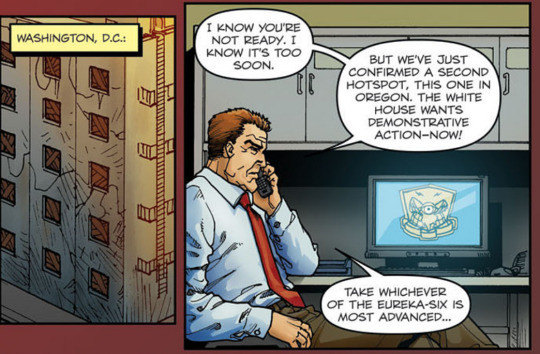
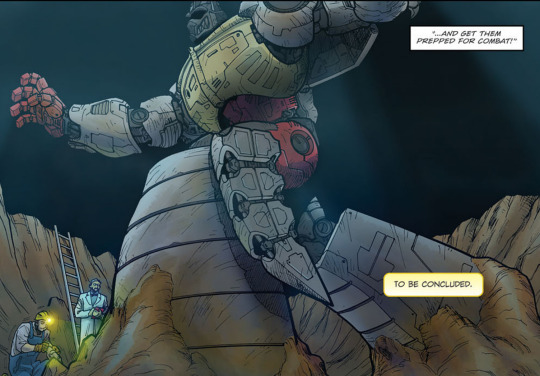
1 note
·
View note
Text
Headcanon / Rimas Gym
About Rima and The Gym
Rima does not attend a NORMAL Gym, The Gym she goes to is specifically a parkour gym.
She visits this gym Frequently. (At least 2 or more times a week) It's easy to tell when she is making plans to visit or has visited, because she will wear sneakers instead of her usual heels. Rima can get about Mid-way Up "The Tower" Before she starts to struggle, and becomes a fall risk. Vee and Rima try to push one another off of things often. (They'll even antagonize eachother) Normally, Rima will take "The Tower" with a leisurely cautious pace. But when she has a specific goal in mind, Her speed and sense of caution changes dramatically. - With a goal in place she can move between twice and in rare cases triple her usual speed. - And she'll make risky movements depending on how bad she wants whatever the goal might be. For Rima Her visits to this gym are more about socializing and enjoying herself than it is about the training / the work out. (but that's a bonus she gets) ---------------
About the Gym
The Gym Owner go's by the name of Drax, he has a gravity quirk that allows him to lighten gravity in an area he can visually see.
His office is located at the very top of "The Tower"
----- There are 2 rooms related to workouts. The Warm Up room- This has a series of small obstacles specifically to get gym members and armatures warmed up for "The Tower."
Obstacles in this room cover the basic skills someone might need to navigate the larger / more advanced course.
-----
"The Tower" - is the 2nd room It involves a more in depth parkour course that goes all the way up to the top floor of the building (several stories up)
The further a gym user go's up the more challenging the obstacles become. Scattered in various sections of this course are rest points, that can be reached either by going through the course, Or alternatively. The stairwell which is considered "the back entrance"
Drax will sometimes change up the obstacles in order to keep frequent visitors from getting bored.
Drax's office is located at the very TOP of "The Tower." His office does have a balcony outside of it (in the building) That is treated as a hangout space for anyone who manages to get that far.
(WHEN someone does reach it, Via "The tower course" A small chime will sound off to alert people someone managed to make it all the way up)
The floor of "The Tower" Is mostly a giant Foam pit. the only walkable space is at the front end of the room near the door. Along with a small sitting area for people who just want to observe.
____________
Outside of workout rooms, There is a locker room for both genders, equipped with showers. A front entry way with a front desk and vending machines.
------------
#Headcanons#/I am YAPPING <3/#/come play with her at the gym she doesn't care if you can beat her she'll still be a menace/
1 note
·
View note
Text
Simplify PCB Power Relays: How Does a PCB Relay Work?
Introduction to PCB Power Relays
As an electronics enthusiast, you may have come across the term “PCB power relay" in your projects or research. But what exactly is a PCB power relay, and how does it work? In this article, we will delve into the world of PCB power relays, exploring their components, design, and most importantly, their function and purpose.
What is a PCB Power Relay?
A PCB power relay, also known as a printed circuit board power relay, is an electromechanical device that allows the control of high-power electrical circuits through low-power signals. It is an essential component in many electronic devices and systems, providing an interface between the control circuit and the load circuit.
The Function and Purpose of a PCB Power Relay
The main function of a PCB power relay is to control the flow of electrical current in a circuit. When a low-power signal, such as a voltage or current, is applied to the relay's coil, it generates a magnetic field that attracts or releases a set of contacts. These contacts, in turn, open or close the circuit, allowing or interrupting the flow of electricity to the load.
The purpose of a PCB power relay varies depending on the application. In some cases, it is used for power switching, where it controls the flow of electricity to devices such as motors, lamps, or heaters. In others, it acts as a protective device, safeguarding the circuit from overloads or short circuits. Power relays are also commonly employed in automation systems, industrial control panels, and telecommunications equipment.

Components and Design of a PCB Power Relay
To understand how a PCB power relay works, it is crucial to familiarize yourself with its components and design. The main elements of a typical PCB power relay include the coil, contacts, and the magnetic system.
The Coil
The coil is the primary component of a PCB power relay responsible for generating the magnetic field. It is usually made of copper wire wound around a bobbin or a magnetic core. The number of turns and the gauge of the wire determine the coil's resistance and the amount of current required to energize the relay.
The Contacts
The contacts of a PCB power relay are the crucial link between the control circuit and the load circuit. They are made of conductive materials, such as silver or gold-plated alloys, to ensure efficient electrical conduction and minimize contact resistance. PCB power relays can have various contact configurations, including single-pole, single-throw (SPST), single-pole, double-throw (SPDT), and double-pole, double-throw (DPDT).
The Magnetic System
The magnetic system of a PCB power relay consists of a ferromagnetic core and an armature. When the coil is energized, the magnetic field created by the coil attracts the armature, which is mechanically linked to the contacts. This attraction causes the contacts to move, either opening or closing the circuit, depending on the relay's design and specifications.
How Does a PCB Power Relay Work?
Now that we have a basic understanding of the components, let's explore how a PCB power relay works in practice. The operation of a PCB power relay can be divided into three main stages: the resting state, the activation state, and the switched state.
Resting State
In the resting state, the relay is not energized, and the contacts are in their default position. Depending on the relay's design, this default position can be either open or closed. For example, in a normally open (NO) relay, the contacts are open in the resting state, while in a normally closed (NC) relay, the contacts are closed.
Activation State
When a voltage or current is applied to the coil, it creates a magnetic field that attracts the armature. This attraction causes the armature to move, which, in turn, moves the contacts. If the relay is normally open, the contacts will close, completing the circuit and allowing the flow of current to the load. Conversely, if the relay is normally closed, the contacts will open, interrupting the circuit.
Switched State
Once the coil is de-energized, the magnetic field dissipates, and the armature returns to its original position due to factors such as spring tension. As a result, the contacts also return to their default position, either open or closed, depending on the design of the relay. This completes the switching action, and the relay is ready for the next cycle.
Advantages and Applications of PCB Power Relays
PCB power relays offer several advantages that make them a popular choice in various applications. One of the key advantages is their ability to handle high-power loads while being controlled by low-power signals. This feature allows for efficient and reliable control of electrical circuits, making PCB power relays indispensable in industries such as manufacturing, automotive, and telecommunications.
Another advantage of PCB power relays is their compact size. Since they are designed to be mounted directly onto printed circuit boards, they occupy minimal space, making them suitable for applications where size constraints are a concern. Additionally, they are relatively easy to install and replace, reducing downtime and maintenance costs in case of failure.
The applications of PCB power relays are wide-ranging. They are commonly used in automotive systems, such as power windows, central locking, and fuel pumps. In industrial settings, they play a vital role in controlling motors, pumps, and solenoids. In the field of telecommunications, PCB power relays are utilized in devices like switches, routers, and modems. These relays also find their place in renewable energy systems, home appliances, and medical equipment.
Understanding Different Types of PCB Power Relays
PCB power relays come in a variety of types, each suitable for specific applications and requirements. The most common types include general-purpose relays, latching relays, solid-state relays, and automotive relays.
General-purpose relays are versatile and can be used in a wide range of applications. They are available in different configurations, contact ratings, and coil voltages, making them suitable for both low-power and high-power switching.
Latching relays, also known as bistable relays, have the ability to maintain their contact position even after the coil is de-energized. They are commonly used in applications where power consumption and heat generation need to be minimized.
Solid-state relays (SSRs) differ from traditional electromechanical relays as they use semiconductor devices and optocouplers to control the switching action. SSRs offer advantages such as silent operation, long lifespan, and fast switching speeds. They are often used in applications where high switching frequency and low power consumption are critical.
Automotive relays are specifically designed to withstand the harsh conditions and high electrical demands of automotive systems. They are frequently used in vehicle lighting, wiper control, and ignition systems.
Choosing the Right PCB Power Relay for Your Application
Selecting the right PCB power relay for your application is crucial to ensure optimal performance and reliability. Several factors should be considered, including contact ratings, coil voltage, switching speed, and environmental conditions.
Firstly, determine the required contact rating, which specifies the maximum current and voltage that the relay can handle. This rating should be compatible with the load circuit's electrical characteristics to prevent damage or failure.
The coil voltage is also an essential parameter to consider. Ensure that the relay's coil voltage matches the voltage available in your control circuit. Operating the relay with a higher or lower coil voltage than specified can lead to improper functioning or complete failure.
The switching speed of a PCB power relay is another critical factor, especially in applications where fast response times are required. Consider the relay's datasheet or technical specifications to determine its switching speed and choose accordingly.
Lastly, take into account the environmental conditions in which the relay will operate. Factors such as temperature, humidity, vibration, and shock can significantly impact the relay's performance and lifespan. Choose a relay that is specifically designed to withstand the environmental conditions of your application.
Leading Manufacturers of PCB Power Relays
When it comes to choosing a reliable PCB power relay, it is essential to consider reputable manufacturers known for their quality and performance. Some of the leading manufacturers in the industry include Omron, TE Connectivity, Panasonic, Siemens, and Schneider Electric.
Omron, for instance, is a renowned manufacturer offering a wide range of PCB power relays suitable for various applications. Their relays are known for their high-quality construction, excellent performance, and long lifespan.
TE Connectivity is another trusted name in the field of PCB power relays. They provide a comprehensive selection of relays, catering to different industries and requirements. Their relays are known for their durability, versatility, and advanced features.
Other notable manufacturers like Panasonic, Siemens, and Schneider Electric also offer a diverse range of high-quality PCB power relays, ensuring reliability and performance in demanding applications.
Conclusion: The Importance of PCB Power Relays in Electronics
In conclusion, PCB power relays play a vital role in the world of electronics, enabling the control of high-power circuits through low-power signals. Understanding their components, design, and operation is essential for anyone working with electronic devices or systems.
By demystifying PCB power relays, we have gained insight into their function, purpose, advantages, and applications. We have explored different types of relays and discussed the factors to consider when choosing the right one for your application. Additionally, we have highlighted leading manufacturers known for their quality and reliability.
Next time you encounter a PCB power relay in your projects, remember its significance in providing efficient and reliable control of electrical circuits. Whether you're working on an industrial automation system, a telecommunications device, or a home appliance, PCB power relays are the unsung heroes ensuring seamless operation and protection of your electronics.
0 notes